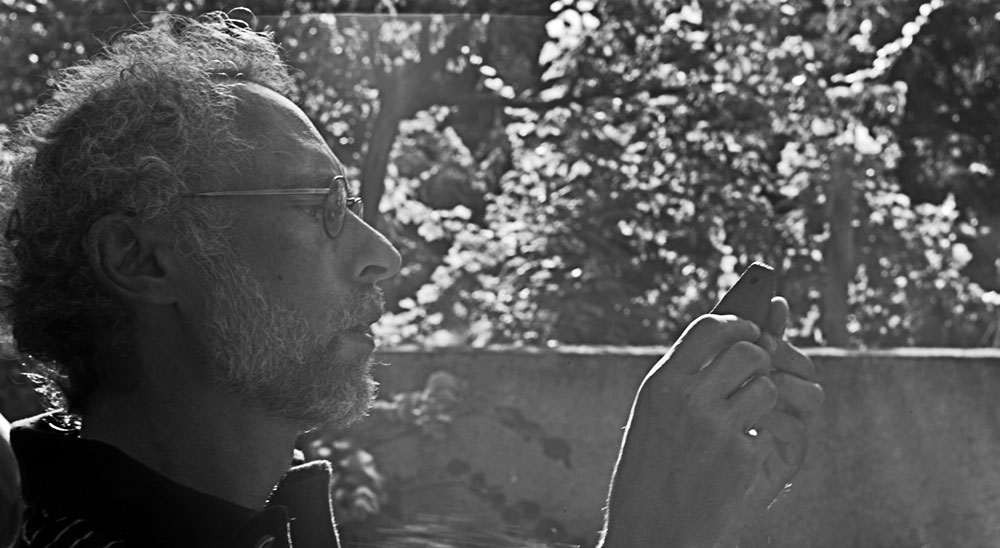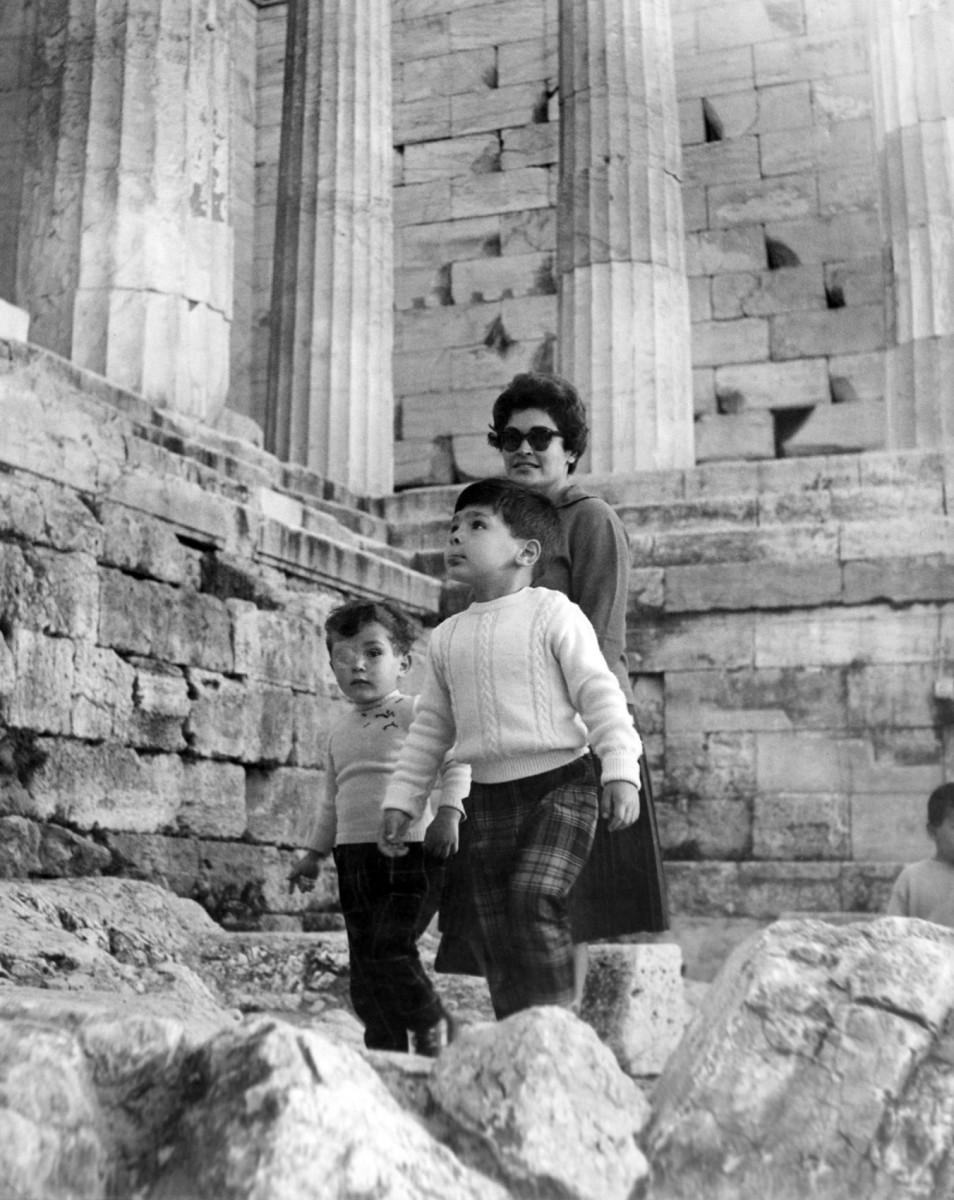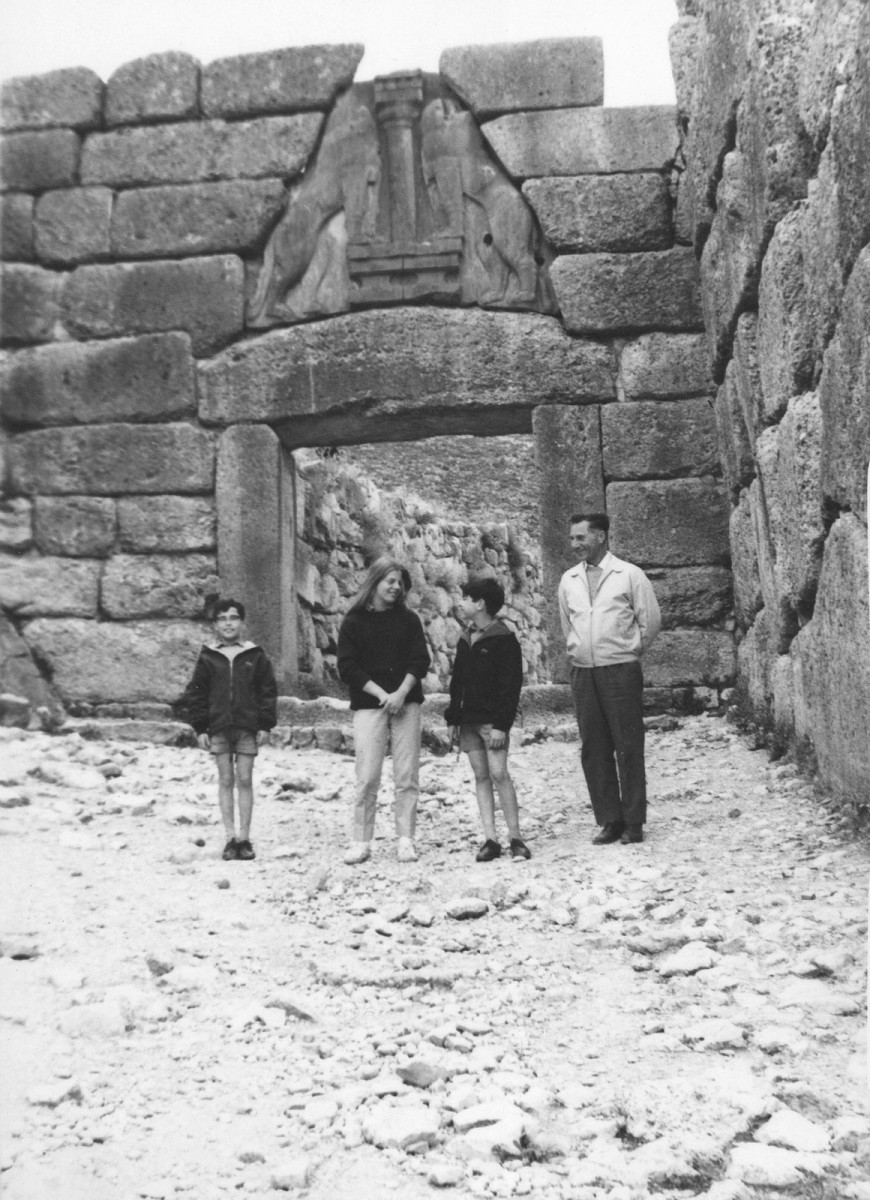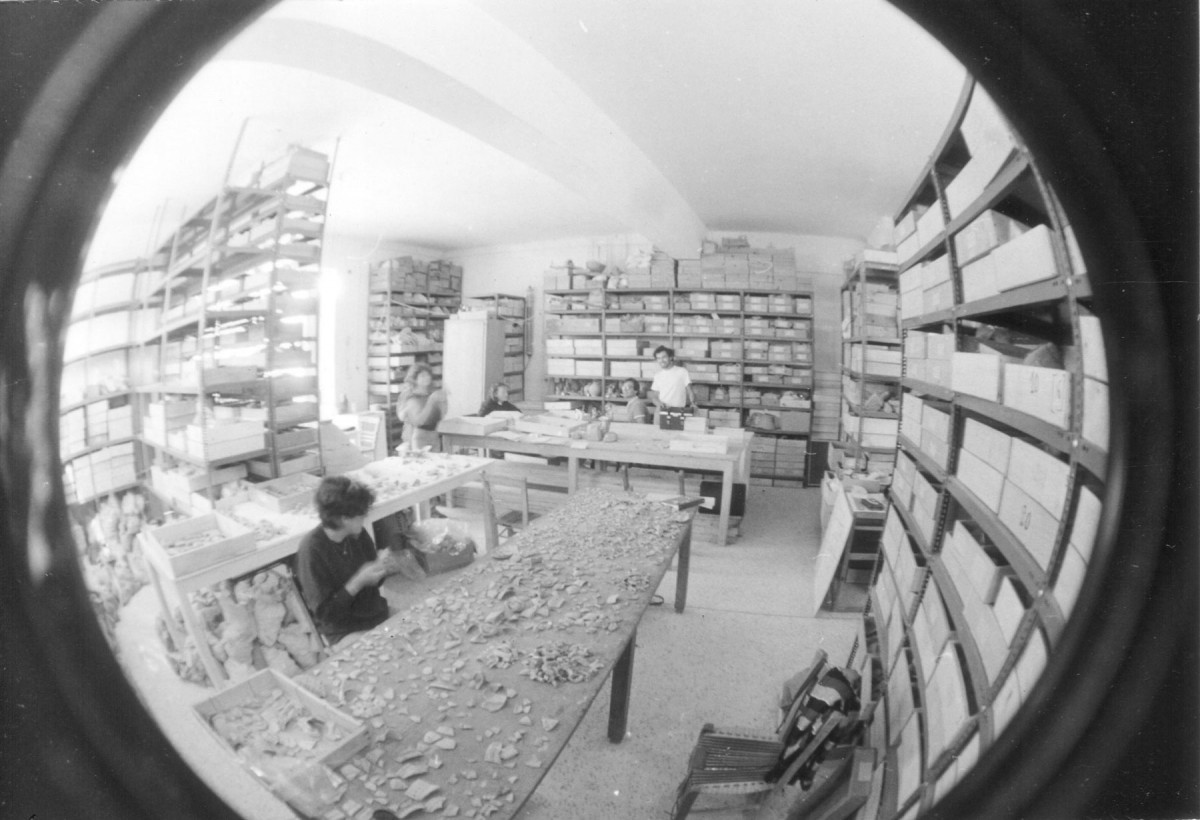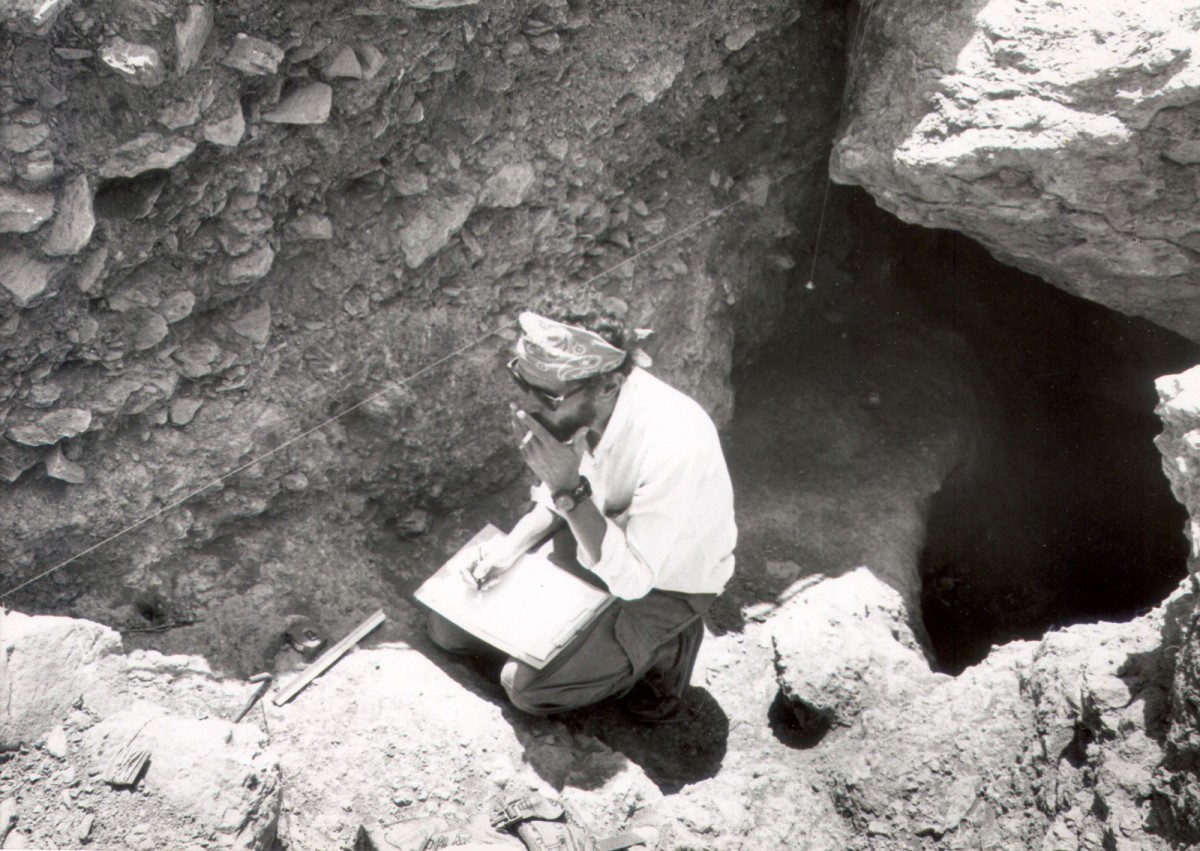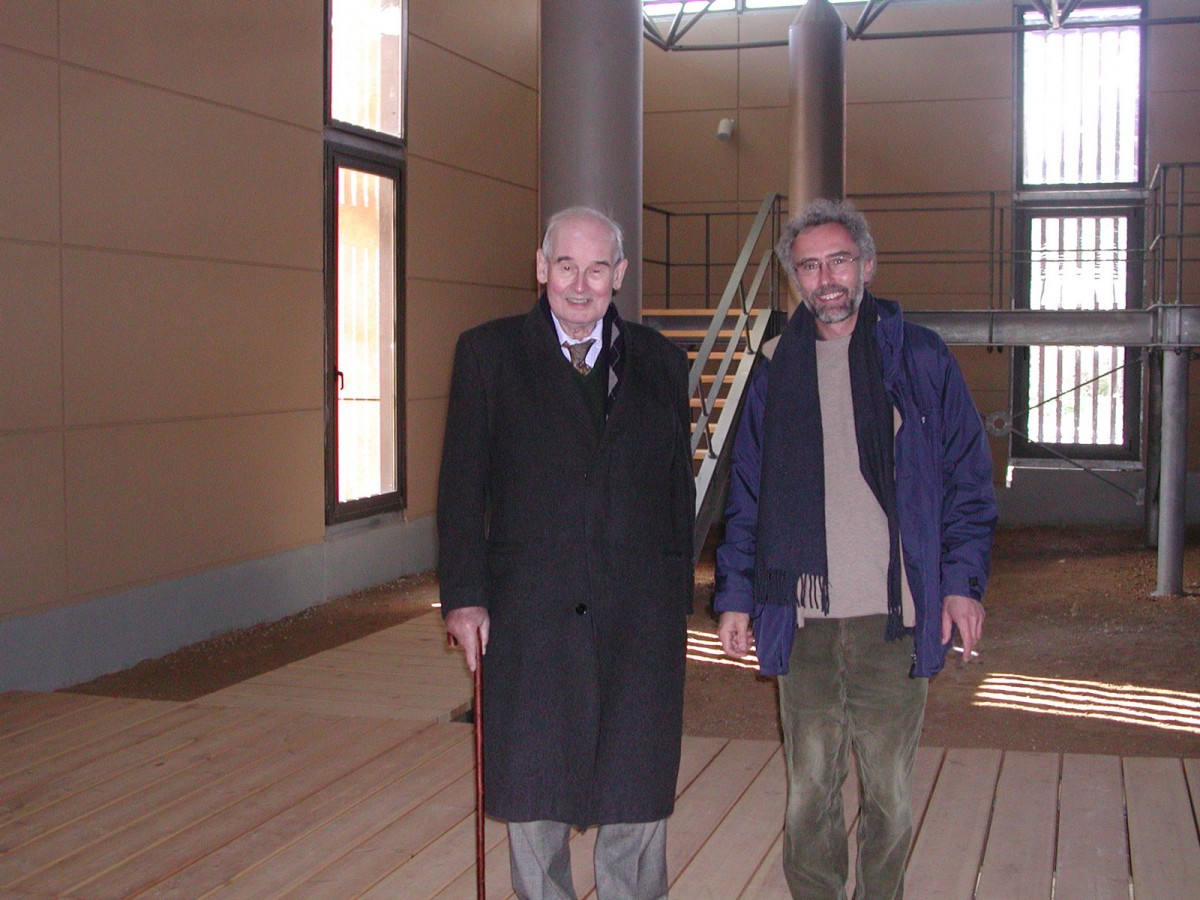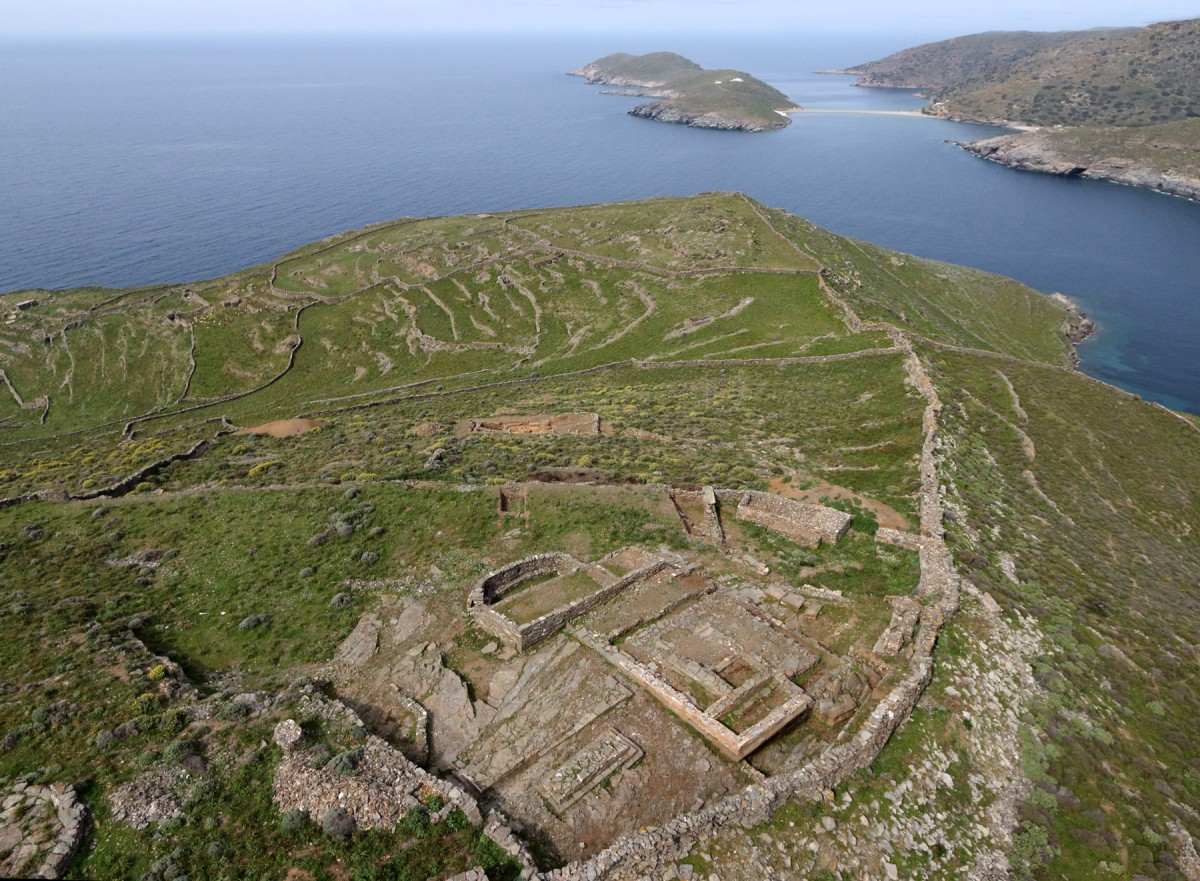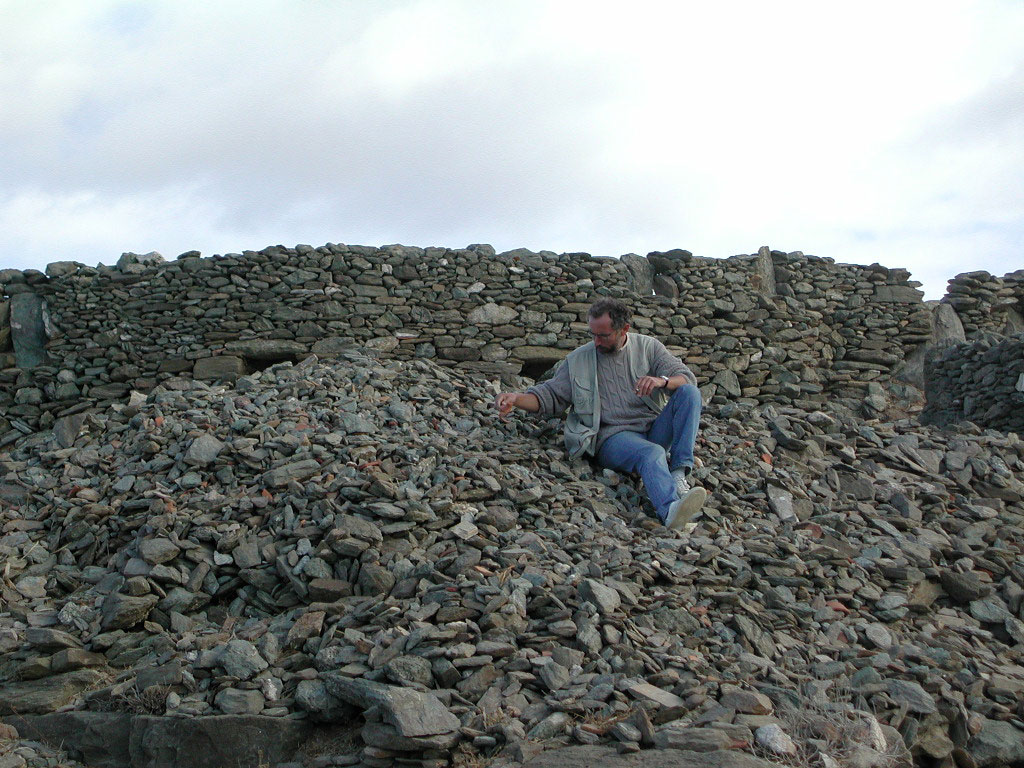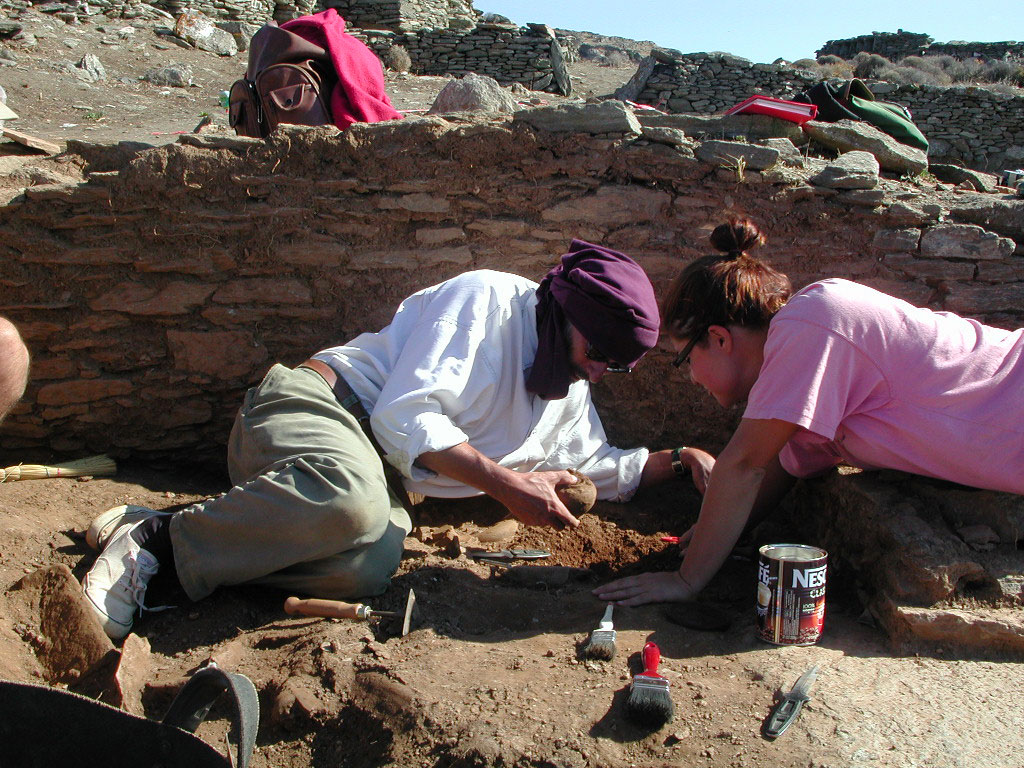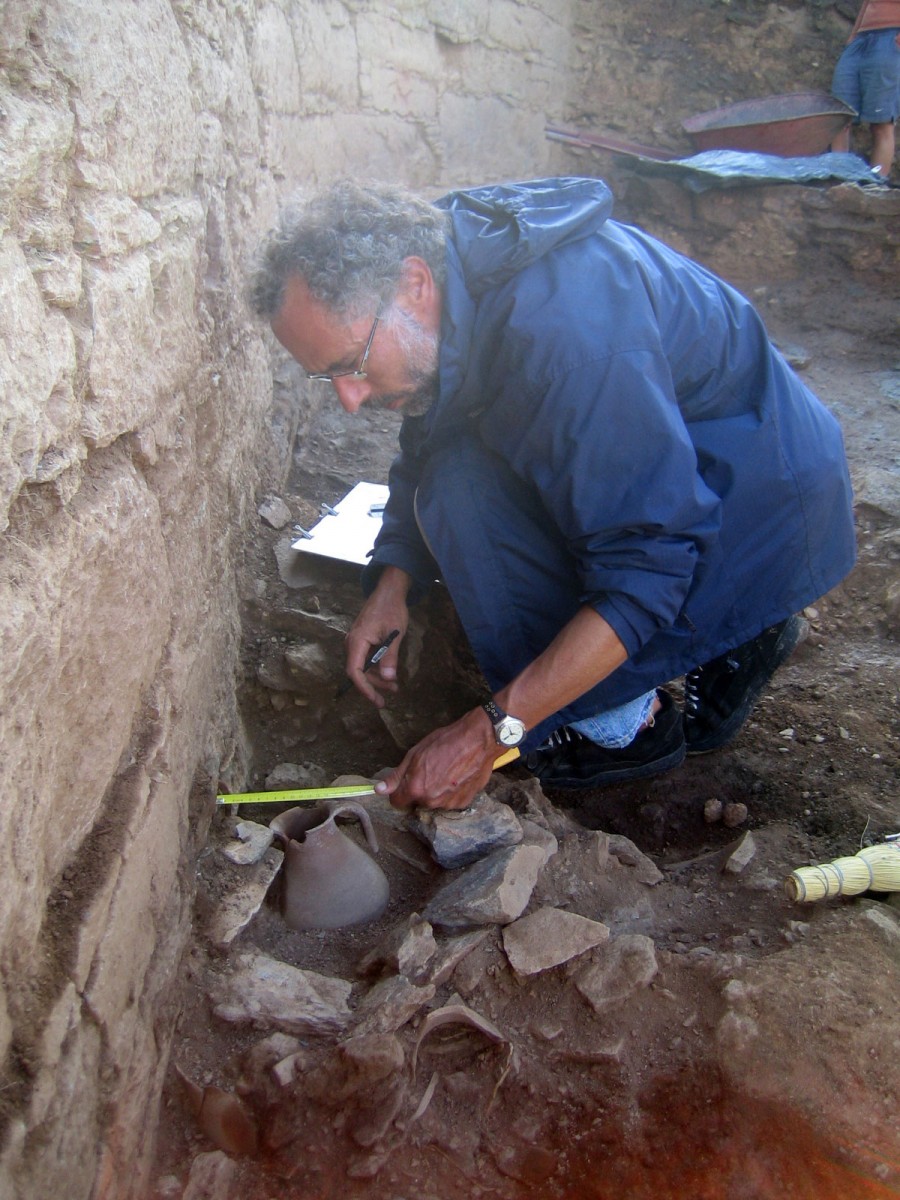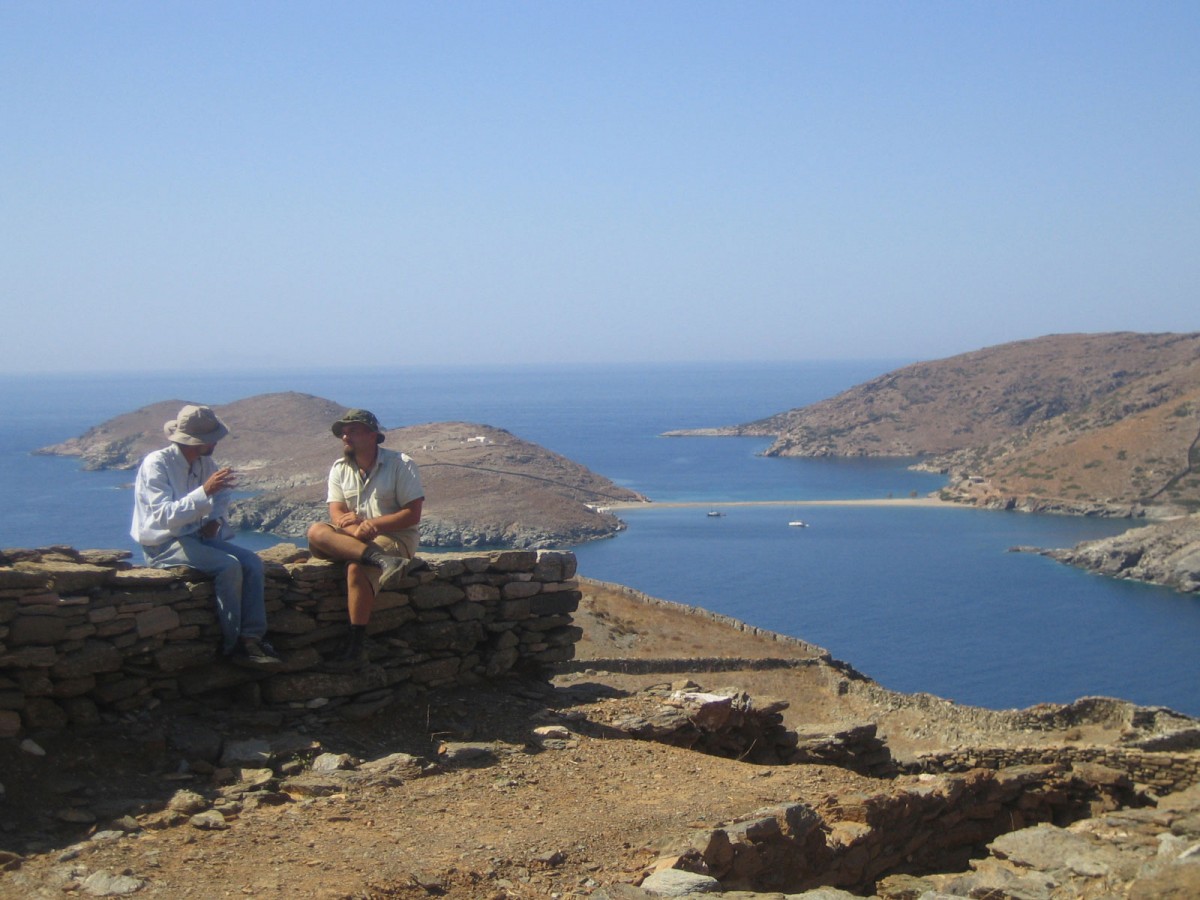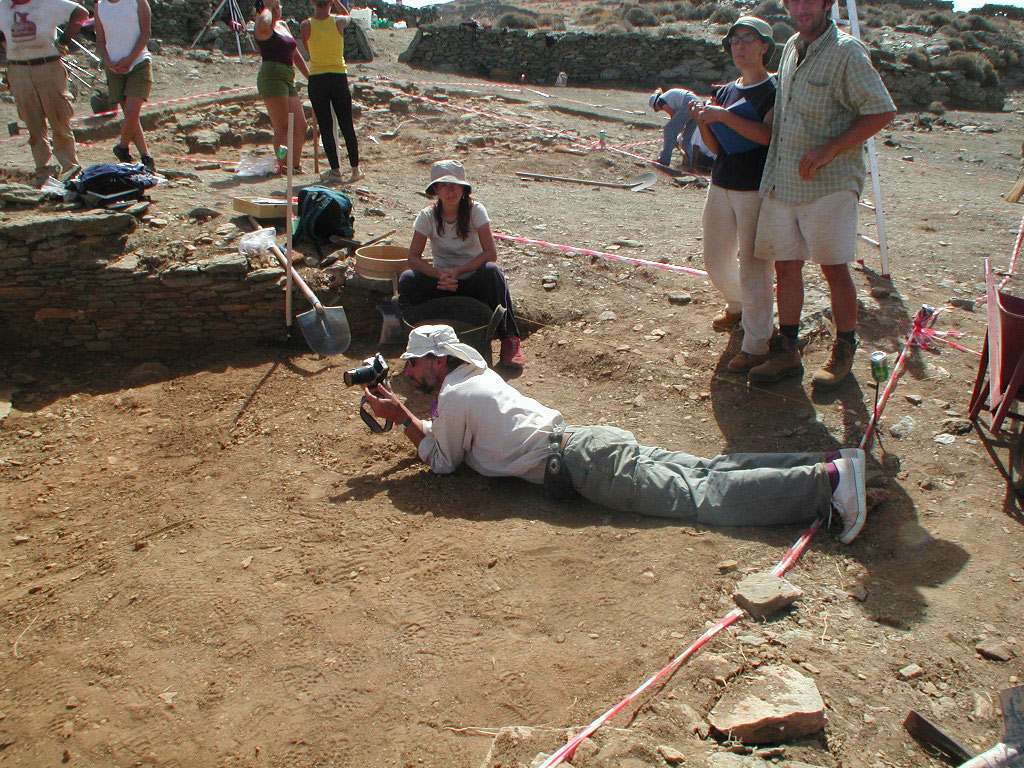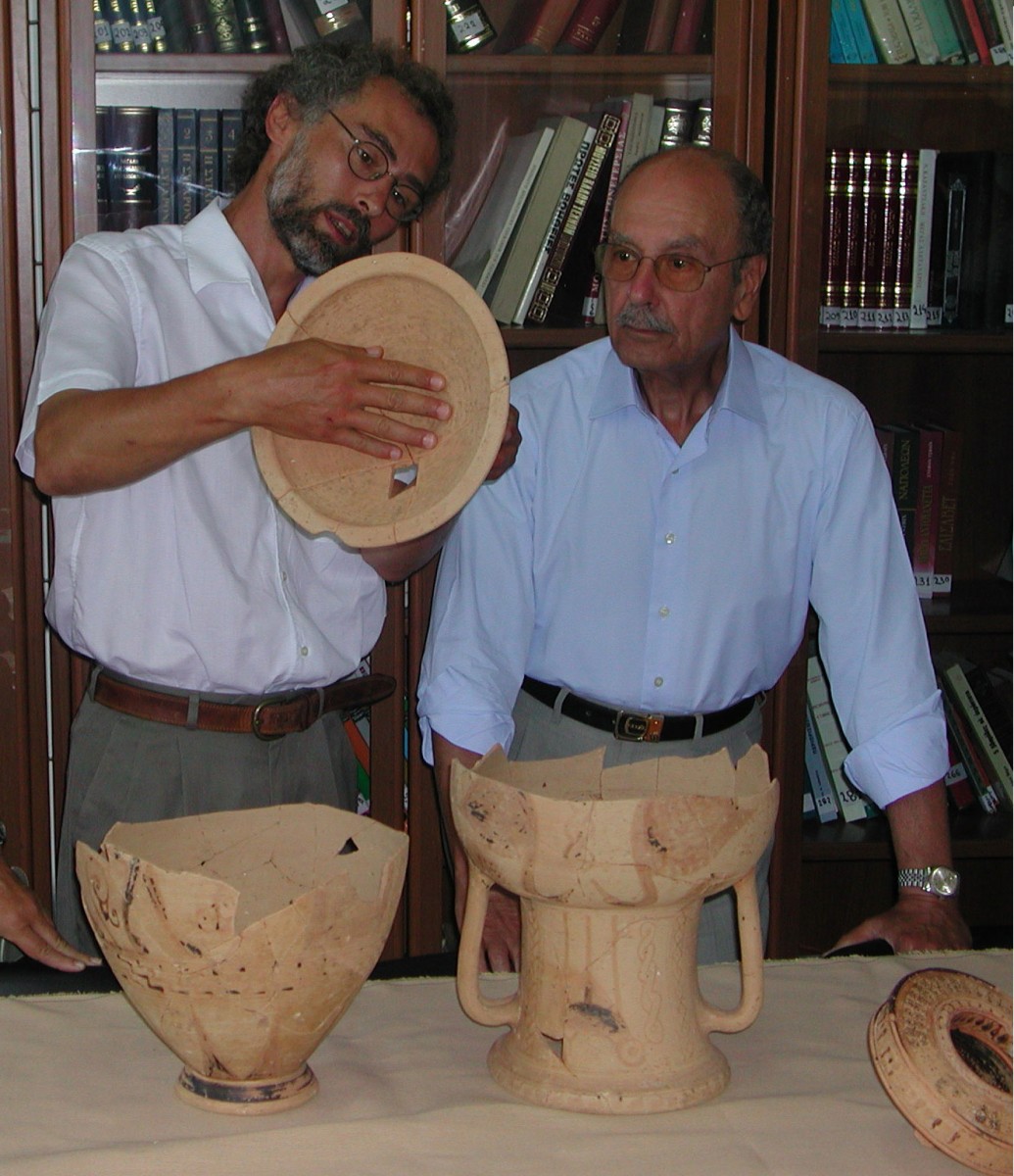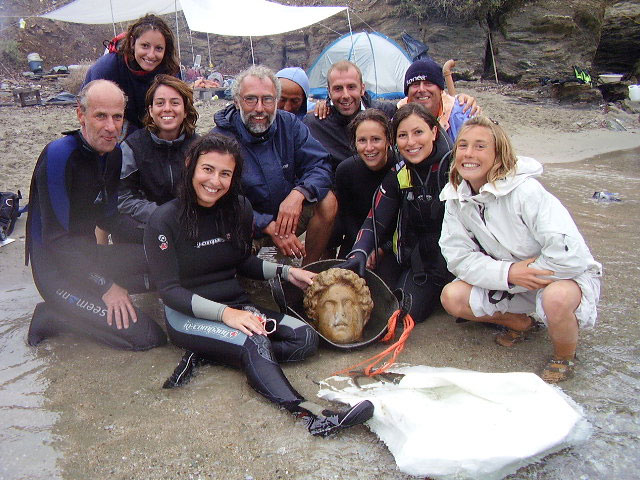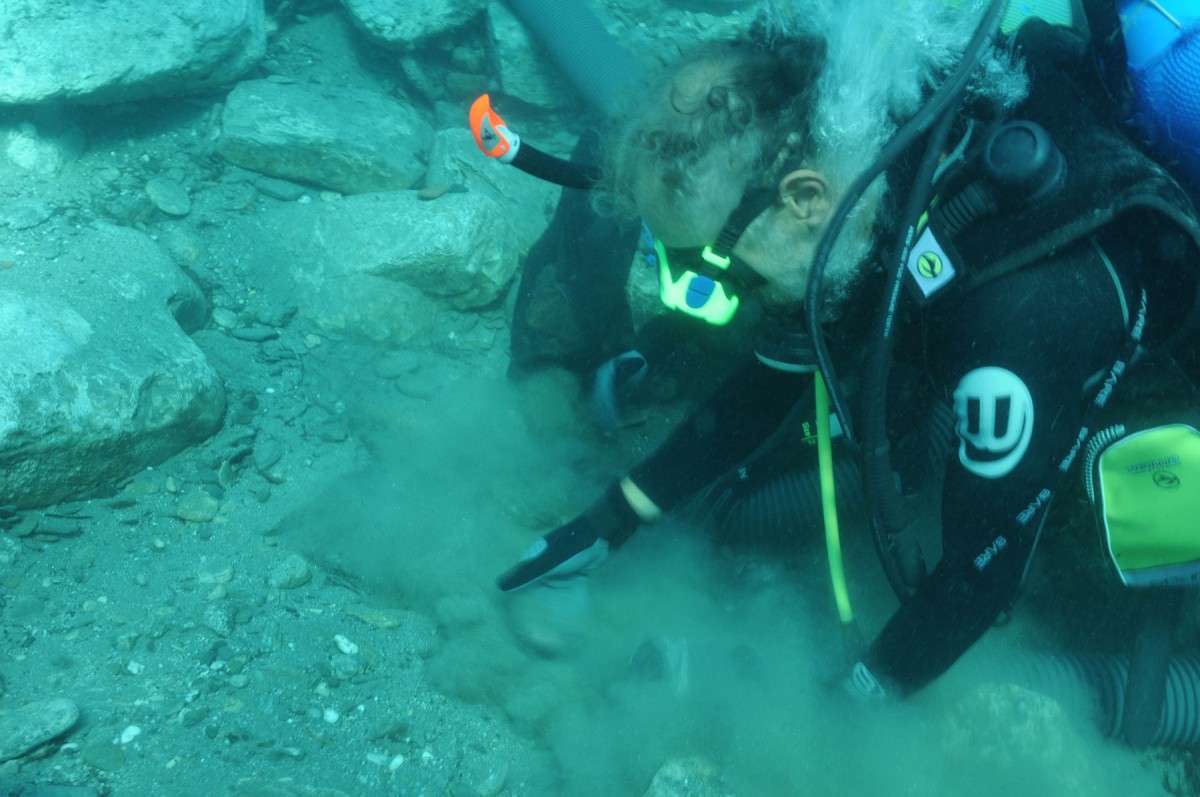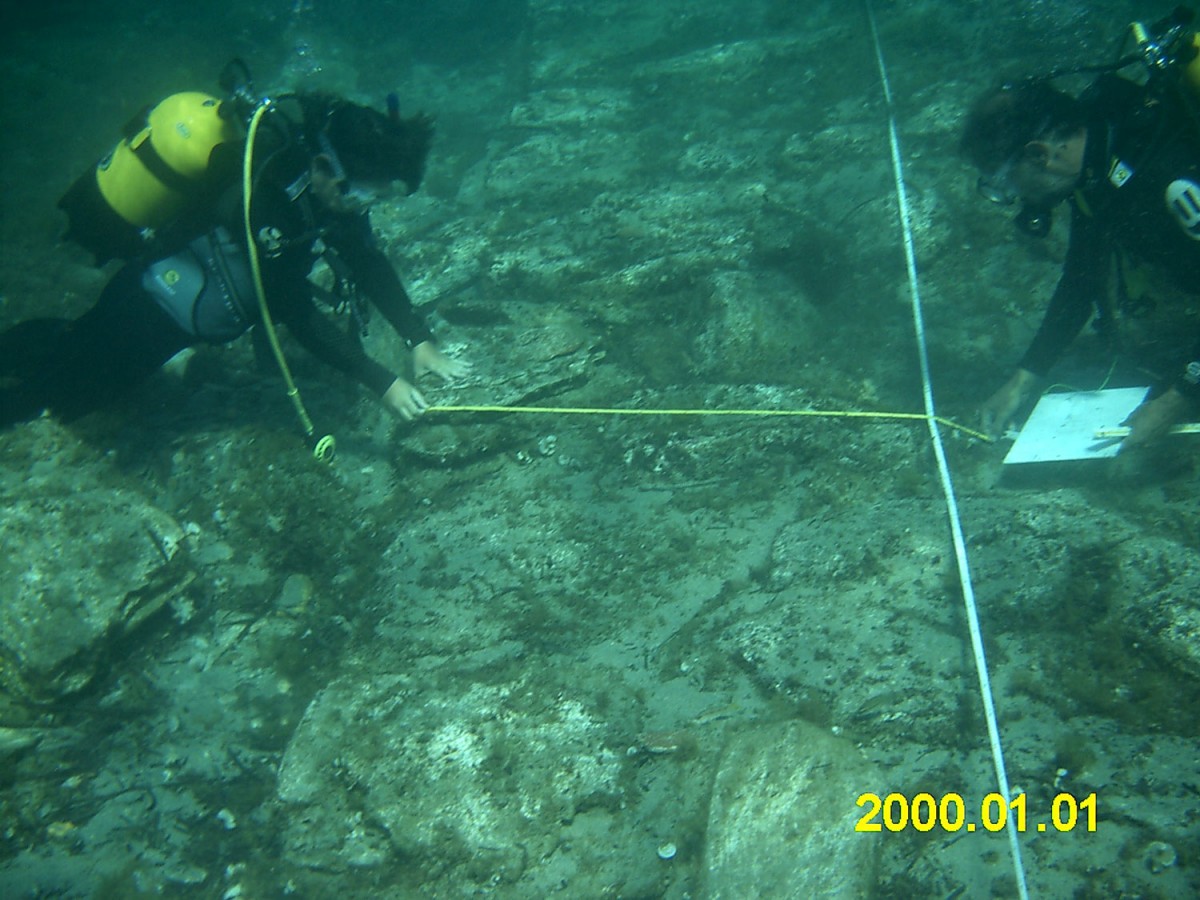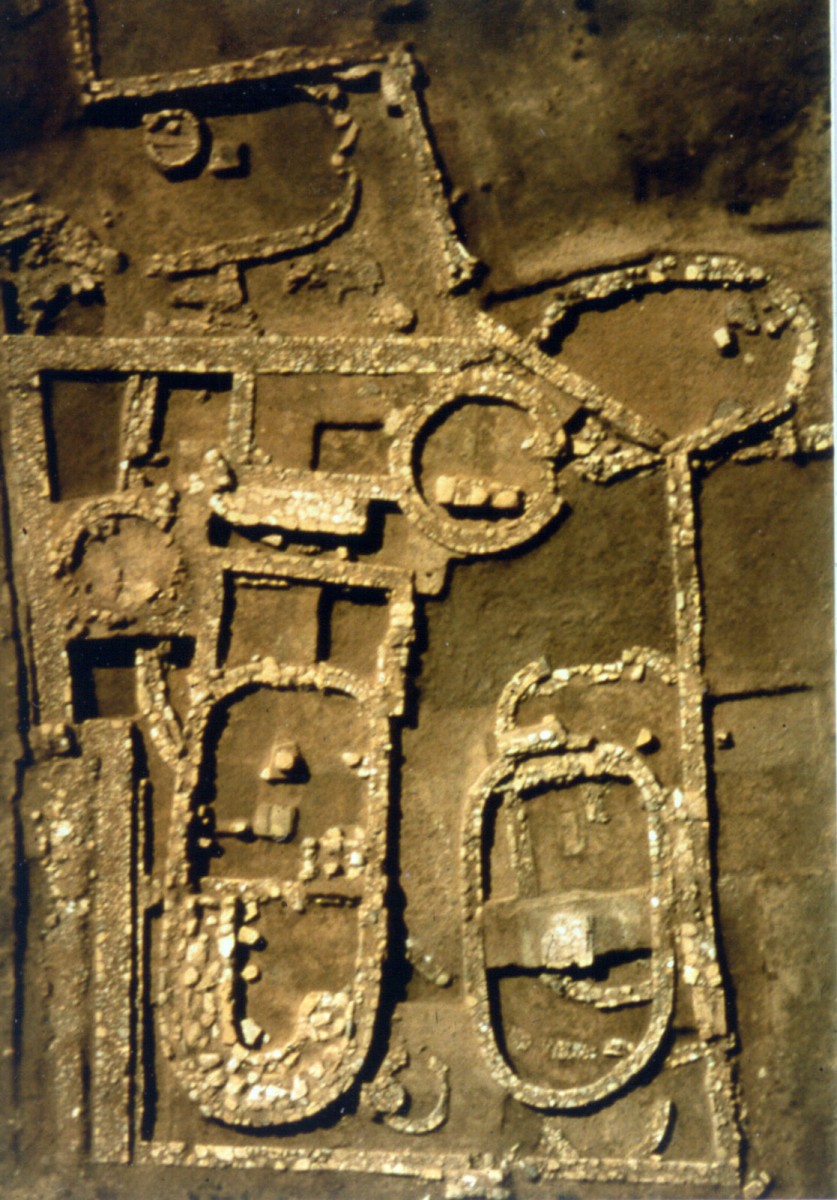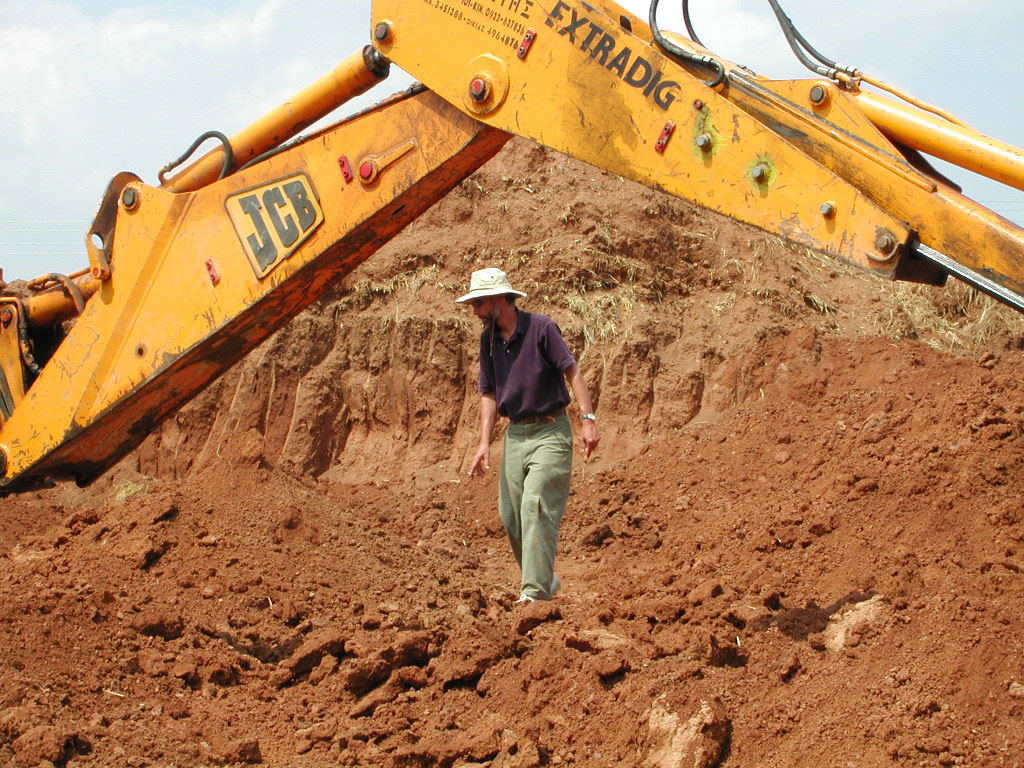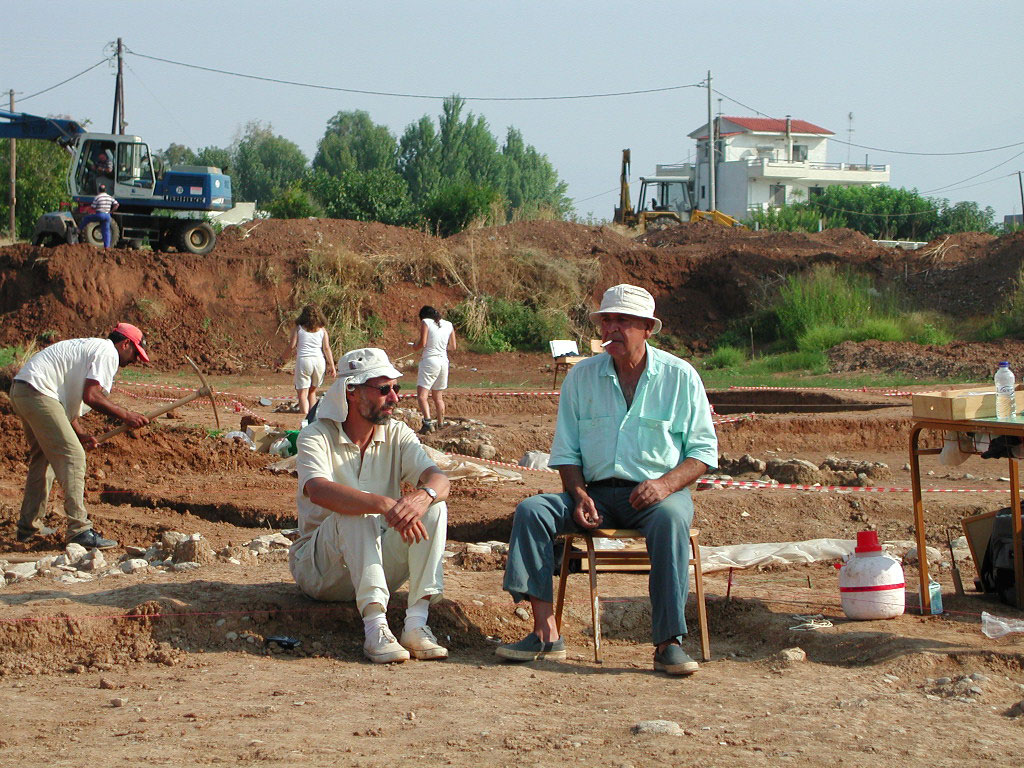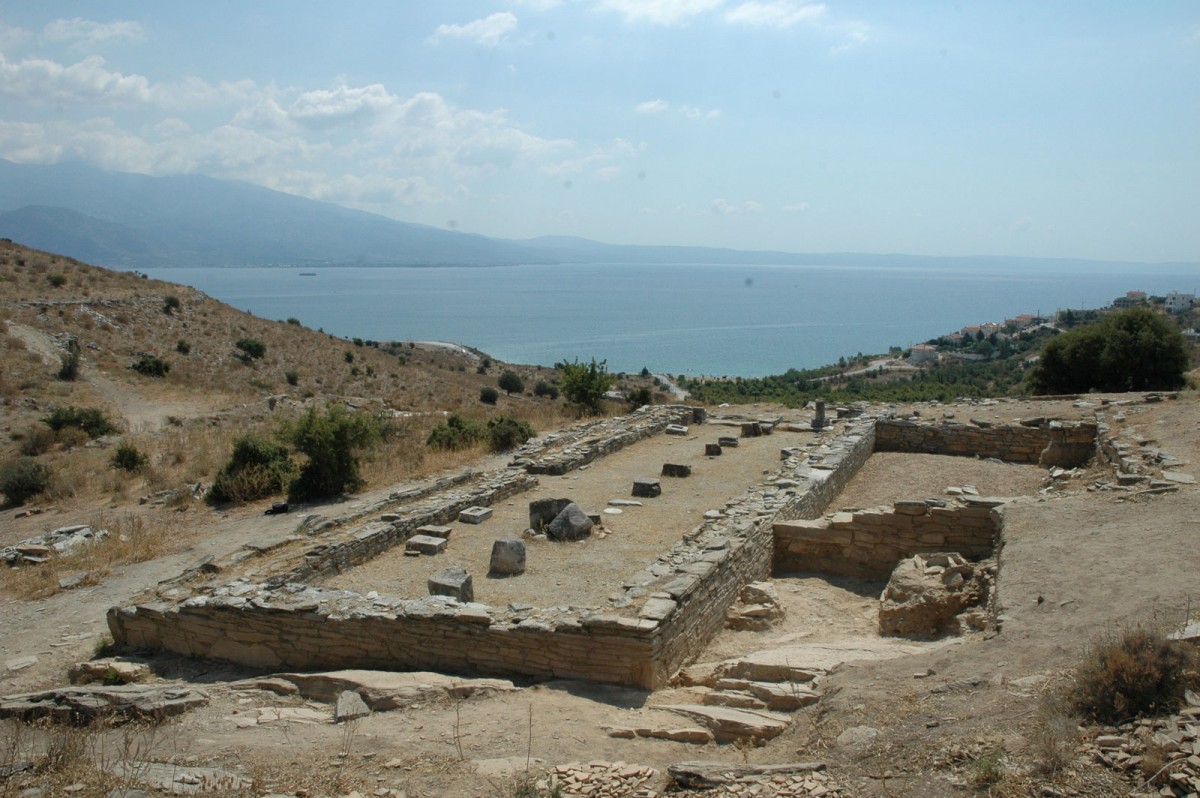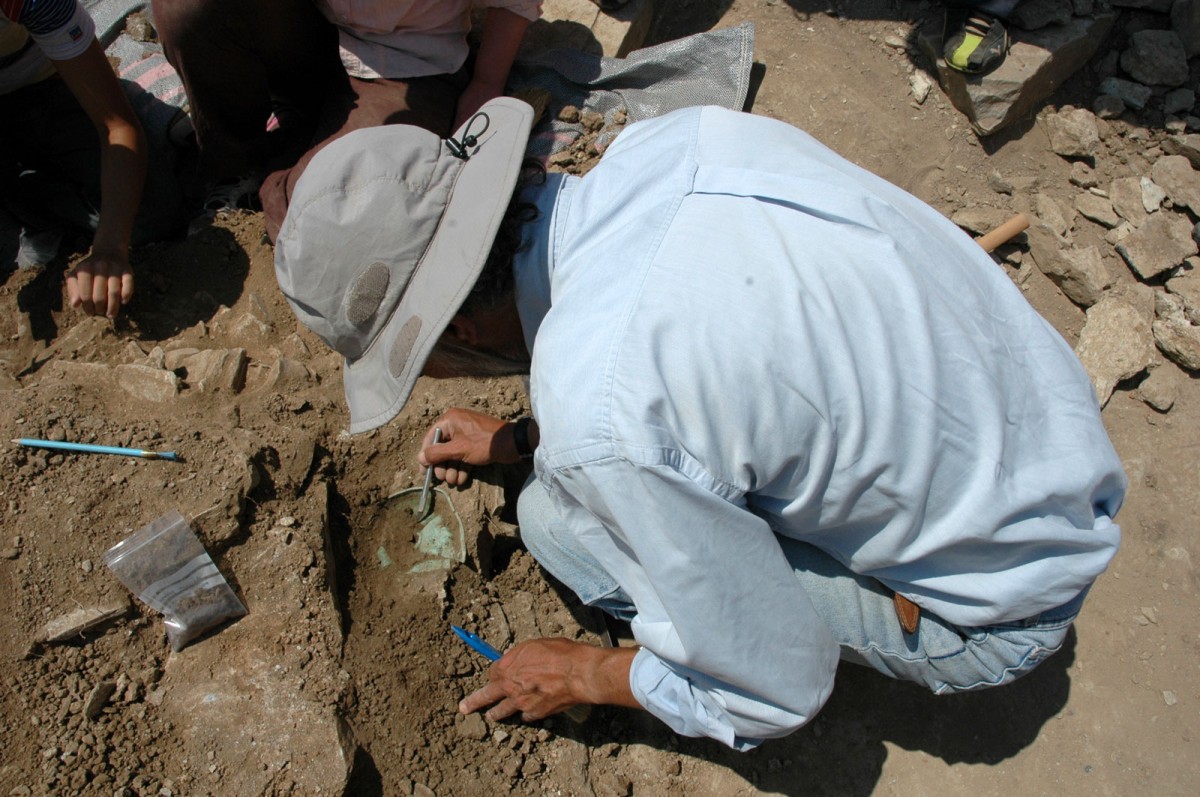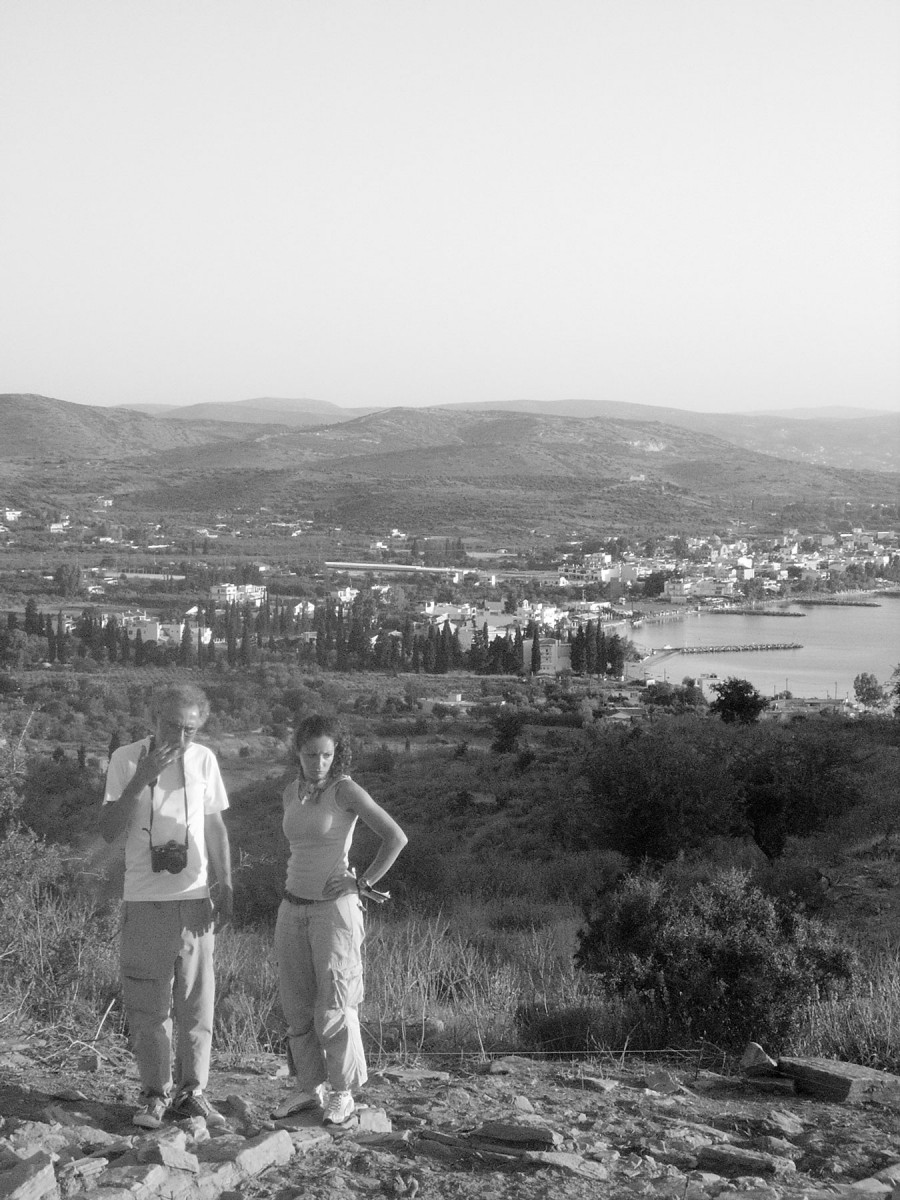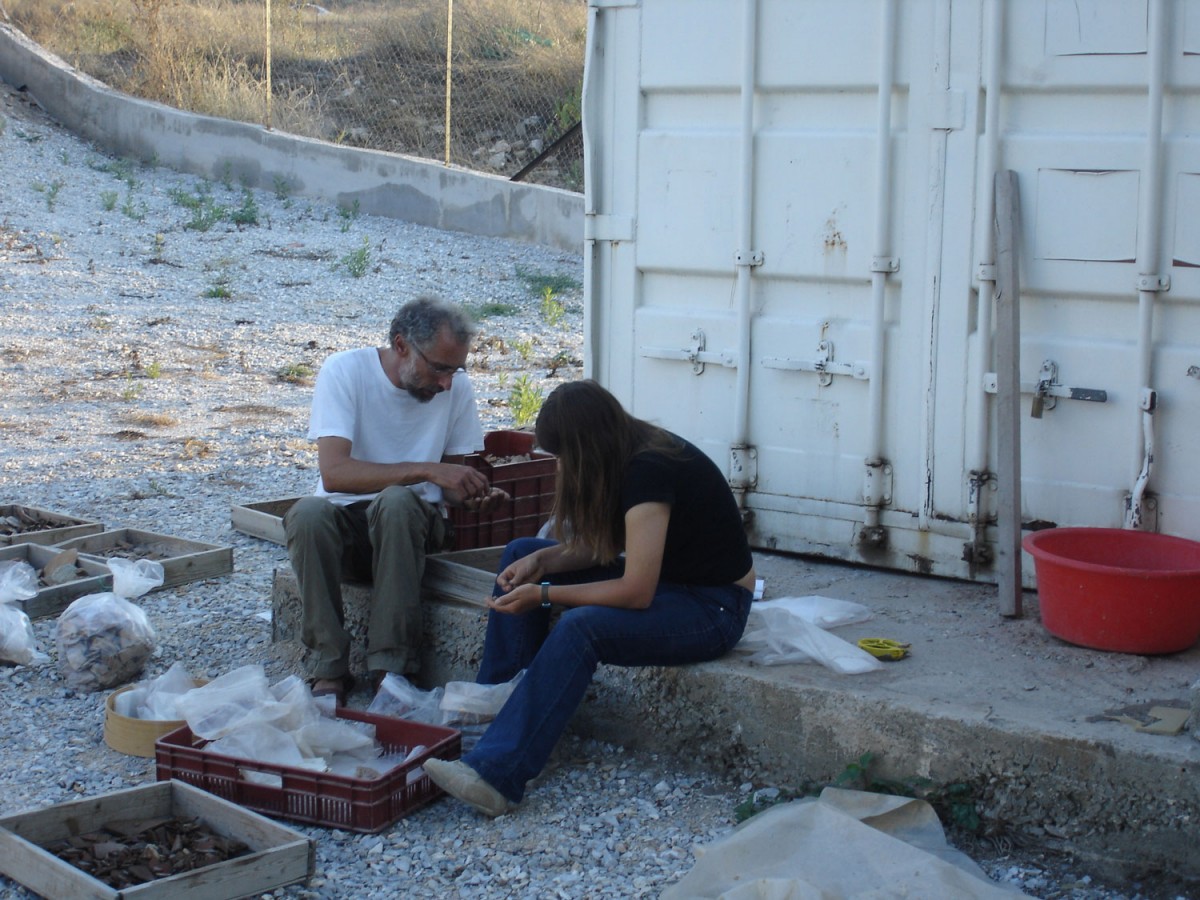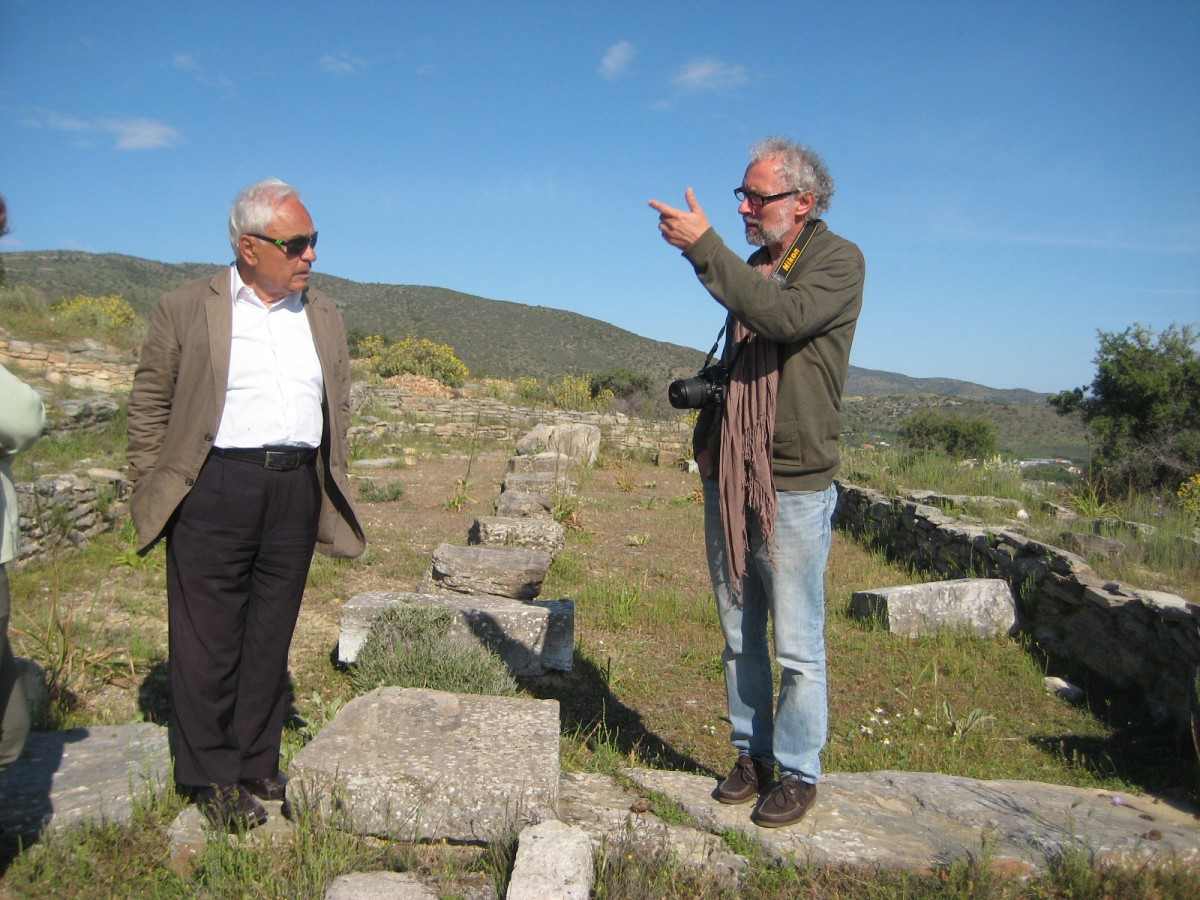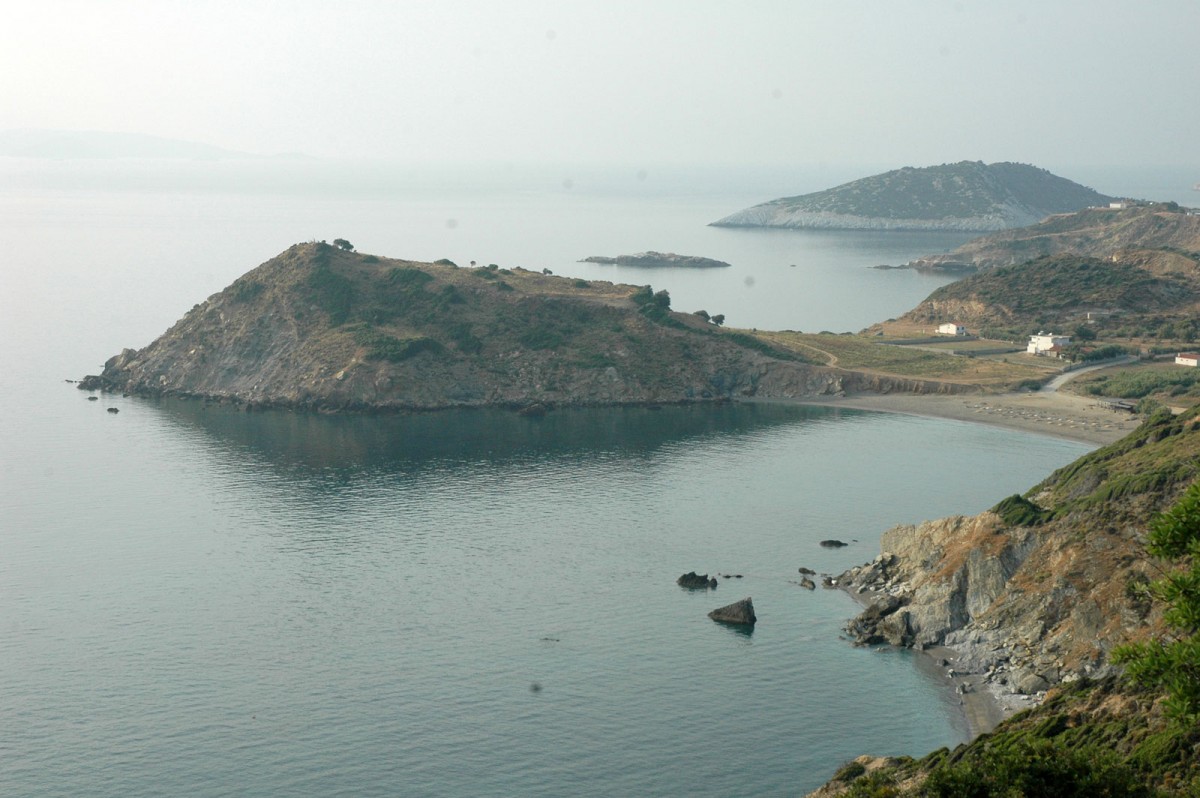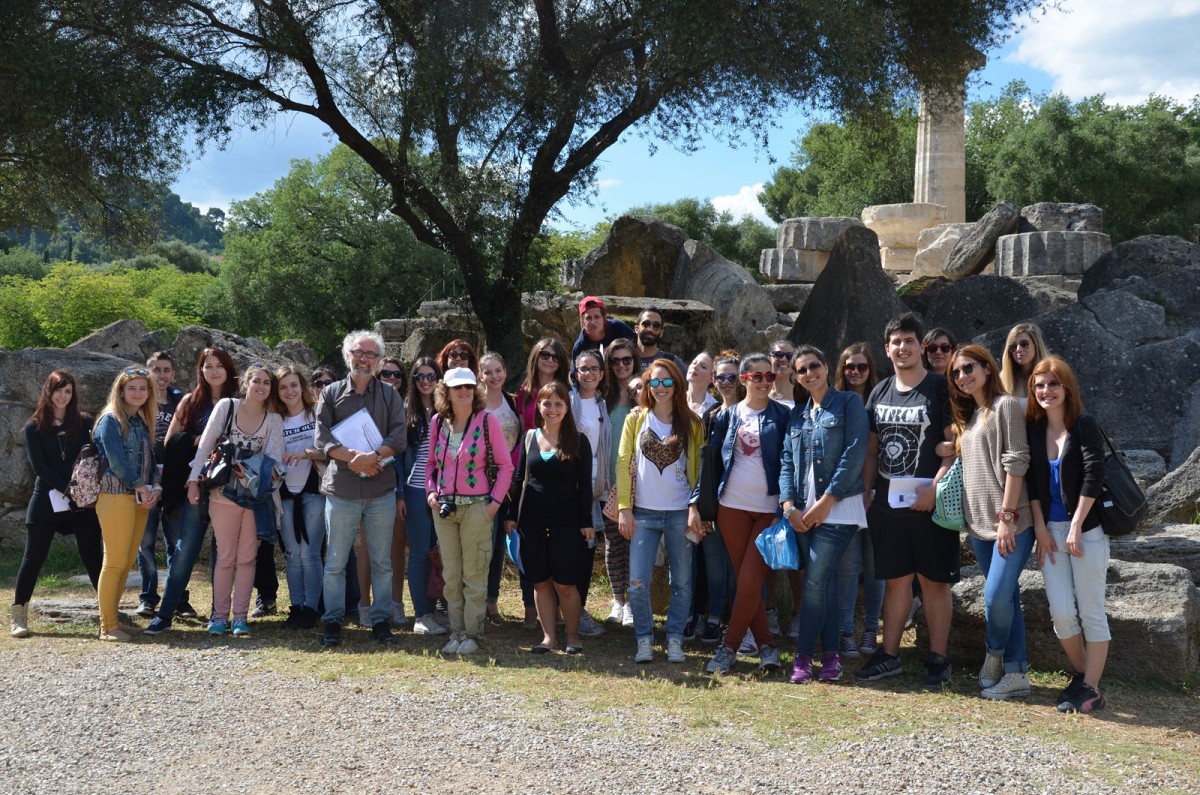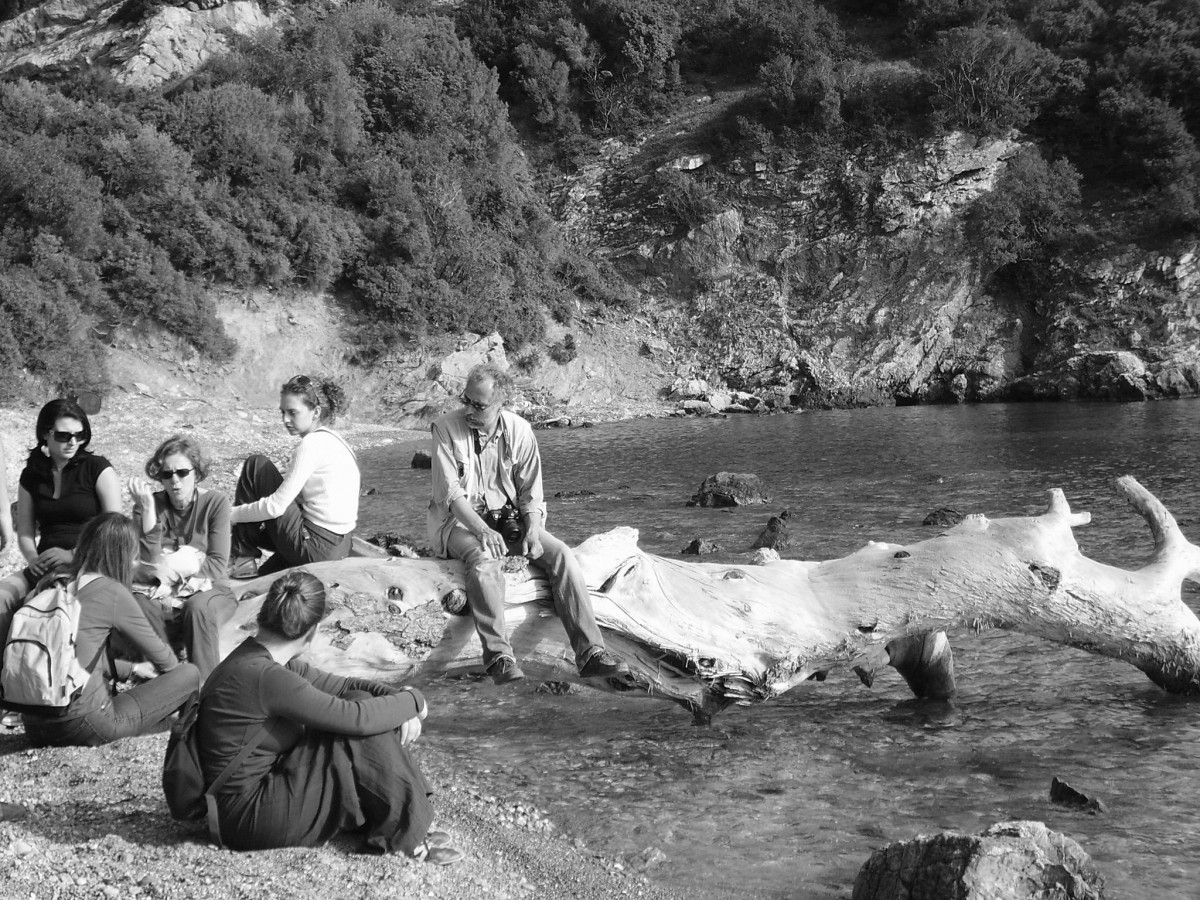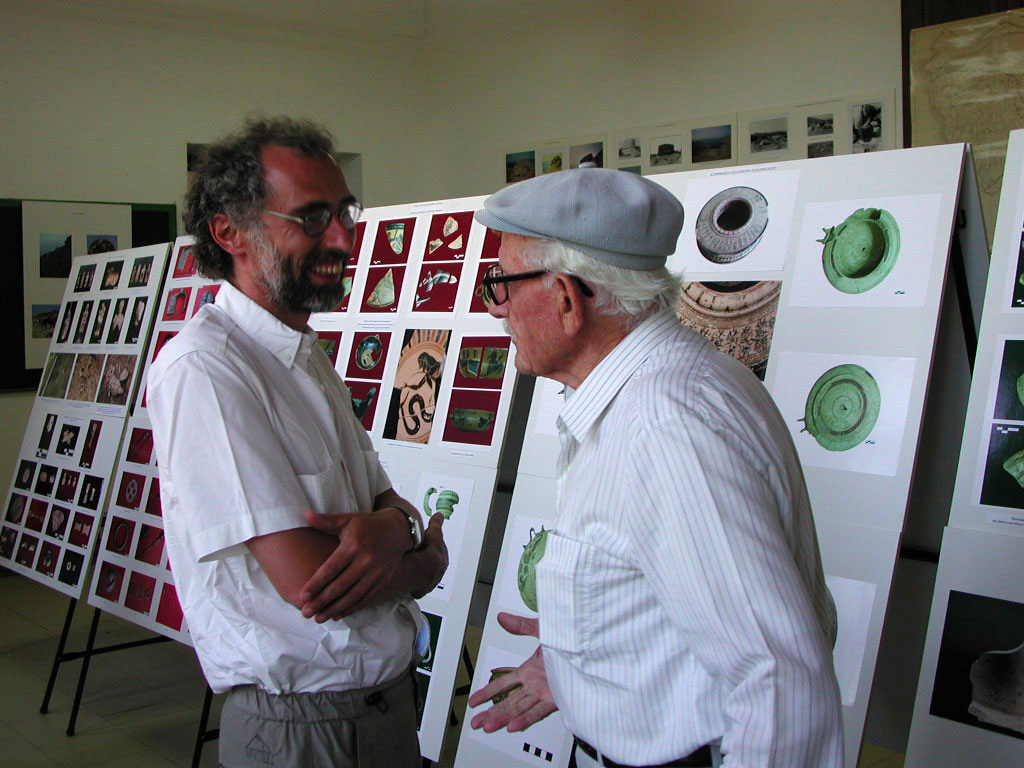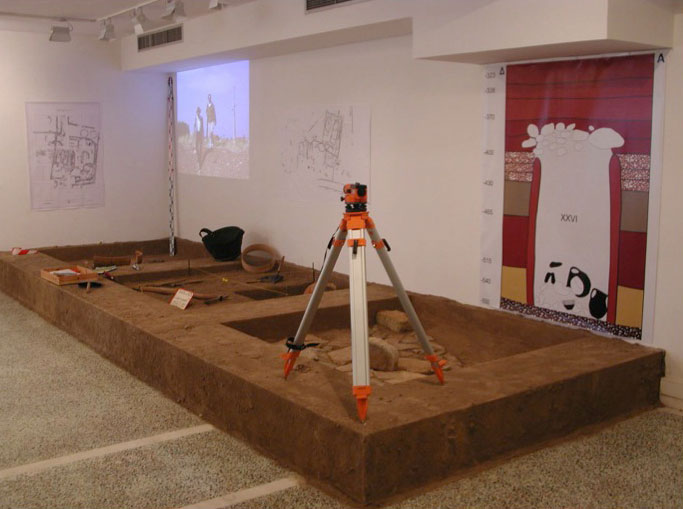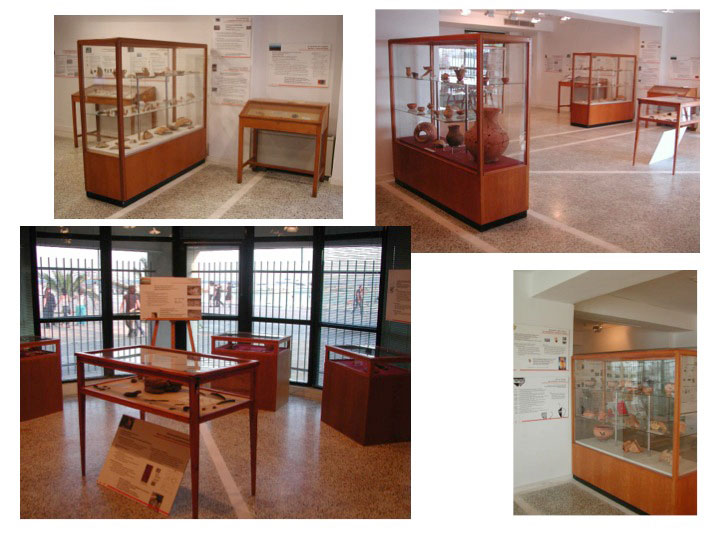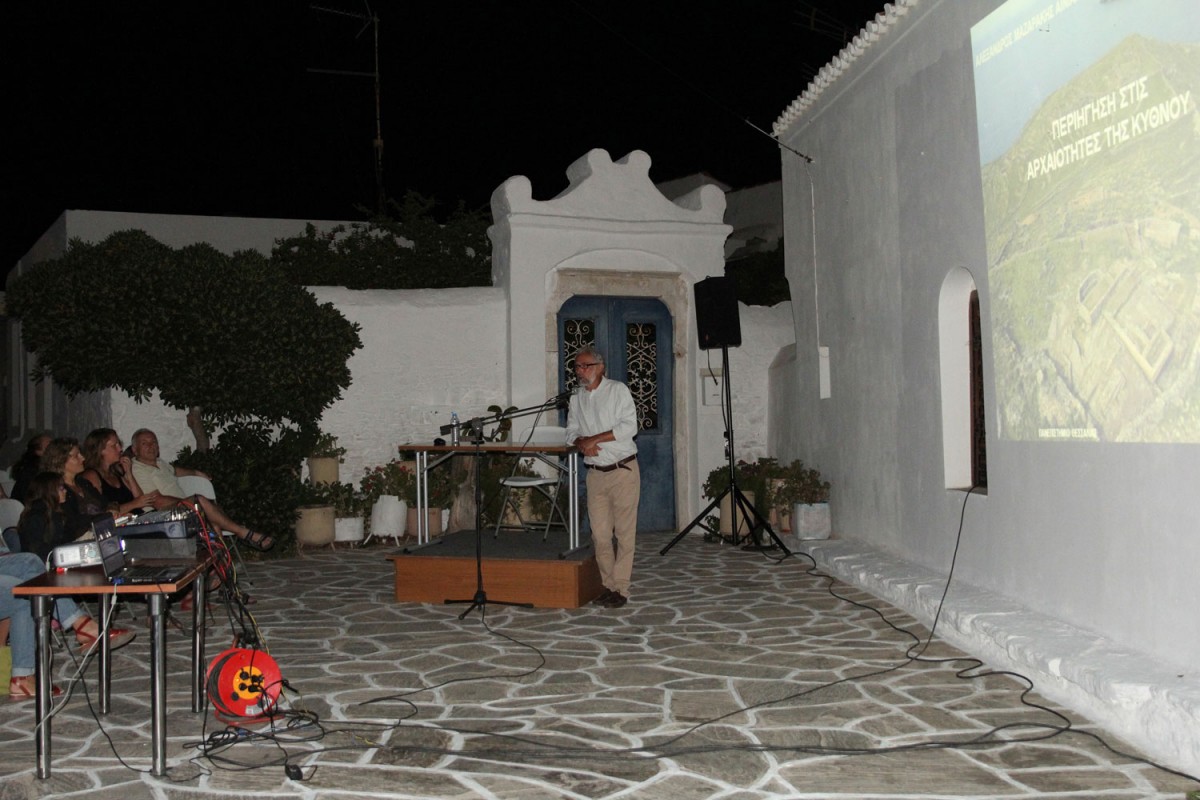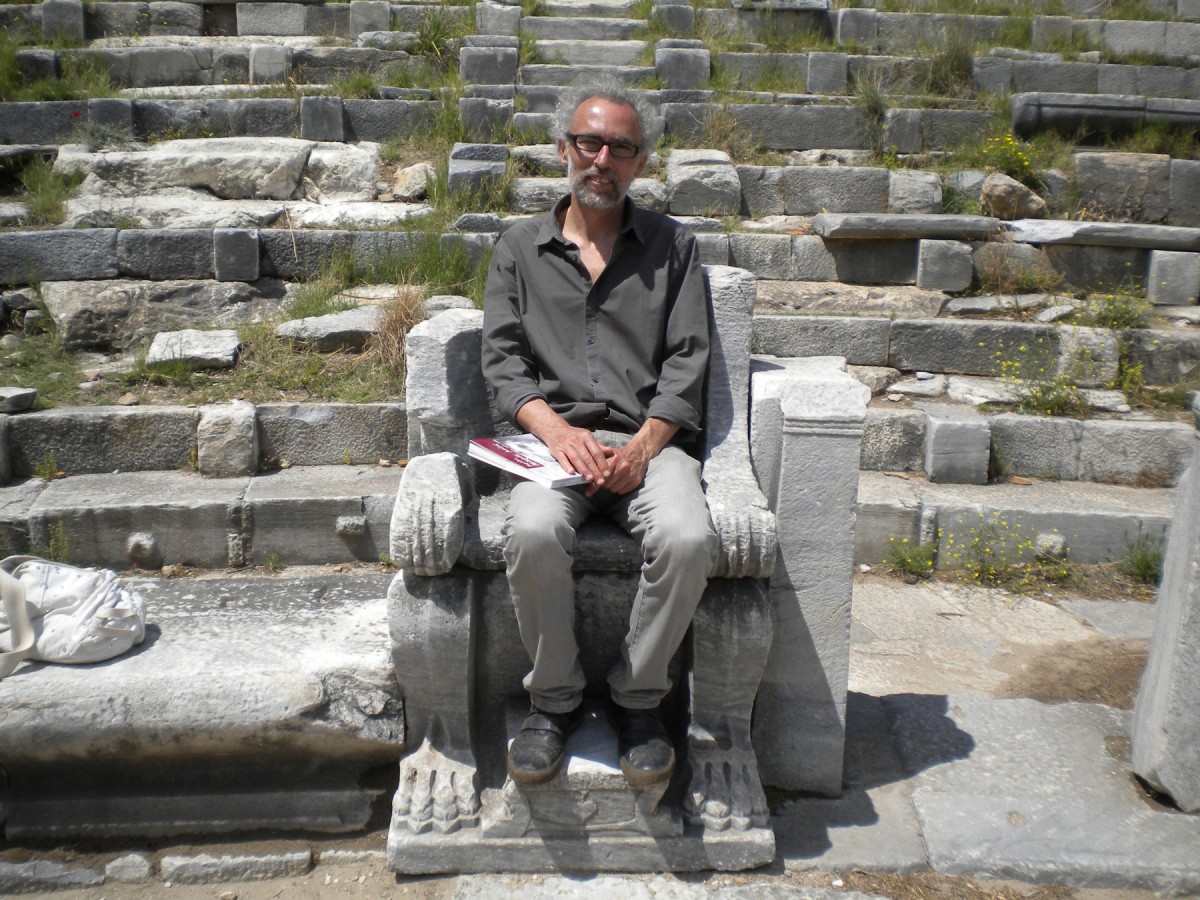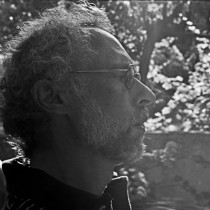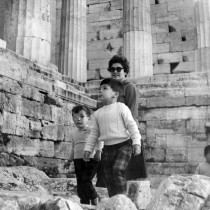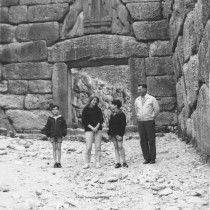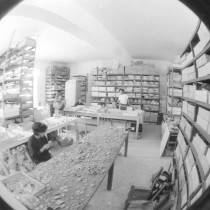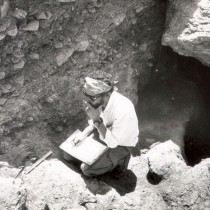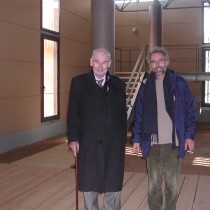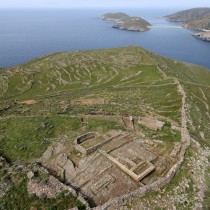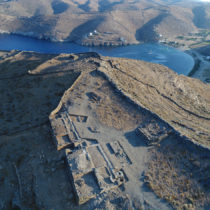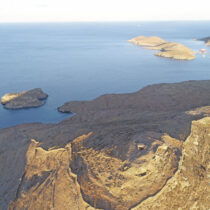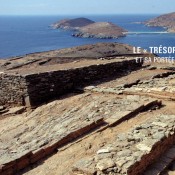Professor Alexander Mazarakis Ainian has an extensive curriculum vitae that is directly accessible on the webpage of the University of Thessaly, Department of History, Archaeology and Social Anthropology. While asking him to talk to us about his excavation work and his European research programmes we shall only indicatively refer to some of the other fields of his activities. One important book of his, not only in size, is on architecture, religion and society in early historical times; Alexander Mazarakis Ainian, From Rulers’ Dwellings to Temples. Architecture, Religion and Society in Early Iron Age Greece (1100-700 B.C.), Studies in Mediterranean Archaeology, vol. CXXI, Jonsered 1997, Paul Åströms Förlag. His area of expertise, the Early Iron Age and matters of Homeric archaeology, becomes apparent in his second book, Όμηρος και Αρχαιολογία [Homer and Archaeology] (Ινστιτούτοτου Βιβλίου-Α. Καρδαμίτσα, Αthens 2000). Over half of his publications, numbering over 50 scientific papers belong to this field, while he has written over 30 excavation reports and book reviews.
He has edited many publications; the Proceedings of the International Symposium Κέα–Κύθνος: Ιστορικές και Αρχαιολογικές Έρευνες [Kea-Kythnos: History and Archaeology] (jointly with Lina Mendoni, Athens 1994/1998), the Proceedings of the 1st, 2nd, 3rd and 4th Archaeological Work of Thessaly and Central Greece (Volos, 2003, 2006, 2009 2012), The International Round Table Oropos and Euboea in the Early Iron Age (Volos, 2007), the catalogue of the exhibition «Αρχαιολογικές Αναζητήσεις: Ανασκαφές στην Ομηρική Γραία» (jointly with Marlen Mouliou, Volos 2008), the International Conference The “Dark Ages” Revisited in memory of W.D.E. Coulson (Volos 2007/2010), the Acts of the International Conference Regional Stories Towards a New Perception of the Early Greek World, in honour of Professor Jan Bouzek (jointly with Alexandra Alexandridou & Xenia Charalambidou,Volos 2016) and recently Les sanctuaires archaïques des Cyclades (Rennes 2017).
Exceptionally active in lectures (90) and presentations at international conferences (70), he has lectured in Greece and many other European countries as well as at major universities and museums in the USA and Canada. Recently he taught for three years as Visiting Professor at Paris IV-Sorbonne and was elected Corresponding Member of the Académie des Inscriptions et Belles-Lettres.
Angeliki Rovatsou: Mr Mazarakis Ainian, between 1992 and 1999you taught Social Archaeology of the Early Historical Era at the Ionian University. How would you define Social Archaeology?
Alexander Mazarakis Ainian: At the time I had just competed my doctorate, From rulers’ dwellings to temples and had begun to publish these ideas in smaller articles and working on the revised version of my thesis which was published later. My aim was to study ancient society through its monuments. I was interested -and still am- much more in the study of ancient societies through their material remains, than in art-history issues. Thus, Social Archaeology could be defined as the study of material remains in order to reveal the behaviour of past communities. At least that was how we had defined it at the time I was teaching this subject in the Department of History at the Ionian University. Of course I did not teach just that, but it was within this general perspective that I taught archaeology − even prehistoric − in the eight years I was under contract.
A.R.: May I ask what prompted you to these studies?
Α.Μ.Α.: I had always liked history, but I started by studying political sciences not archaeology. Along the way I found I was not very satisfied with my studies and it was then I realized that what really interested me was archaeology. So, being already abroad, in Brussels specifically, I was given the possibility of switching to another discipline and so I studied Archaeology and History of Art.
Α.R.: How did you choose the period you specialized in, the Early Historical Period, the Early Iron Age? − I don’t know exactly what you call it.
Α.Μ.Α.: Yes, both Early Historical Period and Early Iron Age are acceptable terms.
Again this was my own choice. I studied at the Université libre de Bruxelles and my professor was Charles Delvoye. He was certainly an important Byzantinist but he was also deeply knowledgeable about ancient Greece and offered us all the courses from the Neolithic to the Byzantine period. He belonged to that generation of archaeologists who had a deep knowledge of classical studies. Consequently, I was slightly undecided as to whether I should engage in the study of antiquity or Byzantium. I finally chose Classical Archaeology, in the broader sense of the term, and being also very interested in architecture, I then proposed to Delvoye that I write my undergraduate thesis on the genesis of the ancient Greek temple. One of the reasons for my choice may have been because I was enthusiastic after my first excavation experience with Petros Themelis, in 1979. I could honestly say that it was next to him that I trained and learned to dig, because he accepted me on his excavation at ancient Kallipolis, submerged today beneath the artificial lake of Mornos, and very quickly entrusted me to oversee the excavation of a Hellenistic temple all by myself! I was then a first year student… What is more, a deposit from the classical era and an early temple of the Geometric period were found under the Hellenistic temple. For me this was an incredible find, a unique experience that I believe determined to some degree my subsequent choices. After that I continued to go on digs every summer, mainly excavations of architectural remains from the Geometric period, initially with Petros Themelis in Eretria, later also with Lila Marangou on Amorgos, all this as a student and so my apprenticeship next to these two teachers and the relationship I developed with them influenced, I believe, both my decisions and my research interests. At the same time though, having completed my undergraduate studies I had to change academic environment and, chose to undertake my thesis supervised by the “sacred monster” of archaeology of the Geometric period, Professor Nicolas Coldstream of University College London. I must confess, however, that prior to this, Anthony Snodgrass had not accepted me for a thesis in Cambridge, considering that the subject I proposed to him was already being studied by other young scholars.
Α.R.: In the most extensive and very impressive book of 1997, resulting from your doctoral thesis of 1987, you say you do not focus on architectural description and analysis, but on the possible interaction between the sacred and secular. Therefore, it was not architecture per se that provided the spark.
Α.Μ.Α.: I have always liked architecture and I was also good at drawing and I always did the drawings by myself; I continue to do so even today, when of course I find time. Consequently architecture was a real part of my immediate interests, without it being cut off from its social context. What interested me was to mainly study the function of buildings, i.e. how these were used in the ancient world. And precisely because I realized very quickly that in the Early Iron Age, the function of buildings was not very clear, I tried to throw as much light as possible on this aspect. Indeed, my research made it clear that it was not at all obvious that temples existed from the start, as we know them from the Archaic and Classical era and that much more complex structures existed which I believed we had not entirely understood. I think that even now we still haven’t understood them entirely, but that’s archaeology, every new find, every new study opens up new horizons for us.
Α.R.: You do however refer to the society of the time; you talk about the “dwellings of noblemen, of rulers”, let’s call them the mansions, about the transition from the chiefs to the kings whom you associate with metallurgy.
Α.Μ.Α.: Yes, this idea came later, due to the important excavation I directed from 1996 till recently (2011) in Skala Oropos. This is an extensive settlement of the Geometric period but also of the Early Archaic period that reached its peak particularly in the second half of the 8th century. A large part of this settlement seems to have been devoted to the treatment of metals, meaning that metal workers were settled there. And of course, for this early period it is particularly significant that we have metalworking workshops in situ and it makes it possible for us to understand the treatment of metals and particularly of iron that was the new metal introduced in the beginning of the first millennium. Metal workers it seems − in my opinion at least − lived within the workshops area at that time, i.e. house and workshop were not yet entirely separate. These activities took place outside the houses, sometimes inside, the workshop was not exclusively a place of work as it will become later. We could say that these activities were more like household affairs.
Α.R.: And did these metal workers have a dominant position, were they the nobility?
Α.Μ.Α.: Probably not the metalworkers themselves. The one though that was in a position to control the production of metal objects and obviously the trading of metals definitely had the upper hand in a society where strength − partly at least − was directly associated with the possession of iron weapons as well as precious metals. So whoever could control trade as much as the production of metals obviously belonged to those who could lead a social group.
Α.R.: What you said a little earlier that “house and workshop were not yet completely separate” reminded me of one of the basic conclusions found in that book of yours that “there was no strict dividing line between sacred and domestic space within settlements at least before the middle of the 8th century B.C.”. Therefore, things were a bit ambivalent, unclear and confused, they hadn’t yet “been put in boxes”.
Α.Μ.Α.: Certainly that is the case, especially from our modern point of view of the ancient Greek world. The picture we have of many matters in antiquity is to a large extent based on written testimonies, most of which date from the Classical period. Nevertheless, material remains from the Early Historical Periodare often not consistent with data from later sources. What I tried to show in my book is that prior to the birth of the city, that is, before the mid 8th century B.C., the concept of an “urban” temple was nonexistent. There were of course roofed temples in sanctuaries on the outskirts or outside cities since very early on, not however inside settlements where this role was fulfilled by rulers’ dwellings. This idea was quite risky when I had formulated it, but today it tends to be confirmed, since after almost 30 years of continuing excavations and data having more than doubled, no temple has been brought to light in an urban setting that dates before this era.
Α.R.: If you agree, I would like to open a parenthesis so as to look at the terms used for periodization. Reading your books and some volumes of Proceedings you have edited, I must admit I am somewhat confused. For example: the Early Iron Age is “the period between the late Bronze Period and the rise of the city”, it is also “the period between the end of the Bronze Age and the early 7th century B.C.” as well as “the period from 1100 up to 700 B.C.” It is also mentioned at the conference entitled The “Dark Ages” Revisited, that according to William D.E. Coulson, in whose memory the conference was organized, the “Dark Ages” more or less cover the period from 1125 till 700 B.C. Let’s take the term “Dark Ages”: you put it in inverted commas which means that you don’t accept it. Why then do you use it?
Α.Μ.Α.: Today, on the whole, most archaeologists don’t endorse the term “Dark Ages” because it was established in the 1970s mainly by the British who used it for the first time, but it was at a time when very little was known about a period which they considered as “Dark”. It was thought that these “Dark Ages” come after the collapse of the Mycenaean world. Nowadays, some very specific findings in particular tend to show that things weren’t exactly like that, that’s why we avoid using the term “Dark Ages”. These “Dark Ages” are approximately equivalent with the 11th, 10th and possibly the beginning of the 9th century B.C.
Finally I believe that “Dark Ages” as a term should no longer be used systematically and indeed is tending to become extinct. But we do however refer to this term particularly in regards to some older studies. In that specific conference that you mentioned, The “Dark Ages” Revisited, I referred to that specific term on one hand because I was referring to a booklet of W. Coulson, in whose memory the conference was organized, and on the other precisely because it had been used many times in the past and that conference essentially was somehow re-examining the whole issue and was redefining the so-called “Dark Ages”.
Α.R.: Don’t we say that the end of the Mycenaean era is around 1100 B.C.?
Α.Μ.Α.: Around then, if we use “absolute” dates. As we said before, today we avoid the use of the term “Dark Ages”, but we continue to use it conventionally. Otherwise I could say that we use many “synonyms”. Let me explain: “Early Historical Times” is a broad term covering the period between the end of the Mycenaean period till the birth of the city, meaning up to the end of the 8th century B.C. The “Early Iron Age” is also used, because it is the period when iron is widely introduced in the Aegean. Consequently, there is some difference, depending on how someone wishes to use each term. And then of course there is the terminology used for periodization, i.e. we say that part of the 11th and 10th centuries correspond to the Protogeometric period, the 9th and 8th centuries make up the Geometric period and each of these periods is subdivided into, for example, the Early, Middle and Late Geometric etc. So one is able to use many terms. “Homeric Era” is also quite popular as a term and occasionally may be used by some scholars, though the period they are referring to always depends on the answer given by each scholar to the question: what is the Homeric world and from when does it date? The matter is therefore quite complex…
Α.R.: I shall ask you about that later. For the time being, I would like to ask you one more question that is again connected to your first book. You describe the following four types of ground plans for religious buildings, rulers’ houses, other buildings for domestic use etc: the apsidal, oval, rectangular and circular. And you say that of these ground plans, the apsidal and the rectangular − and not the Mycenaean palatial megaron − are the ones that subsequently became the ground plans of the ancient Greek temple. That is all right in the case of the rectangular, I can immediately understand that, but what about the apsidal?
Α.Μ.Α.: The only real difference between the apsidal and the rectangular is that the narrow rear side of the former is curved, meaning that it forms an arch. Therefore what counts, when we think about it architecturally let’s say, is the architectural form in general and the façade, usually emphasized in temples, at least when these are not peripteral. They are not very different, being in each case oblong buildings, with an entrance on the narrow side, a colonnade to support the roof. In other words, all the features of these two buildings are identical except for the back wall.
Α.R.: Which you consider a negligible difference.
Α.Μ.Α.: I don’t think this feature is so important. On the other hand, curved buildings, meaning oval or circular, could in no way evolve into monumental buildings because their architectural form is not suitable. Gradually, particularly when houses became more complex due to the changes within the family, combined with dense urbanization, curved buildings which could not be easily combined together in agglutinated units or their roofs joined, as we see today in traditional settlements in the Cyclades, were abandoned. When there was need for a very orderly town planning and saving space, obviously these structures had to be abandoned and that is why in Archaic times they were gradually discarded in favour of architectural forms using right angles.
Α.R.: You write again in the same book that the birth of the “urban” temple seems to be connected with the abandonment or change of function of the rulers’ dwellings, the mansions. You add however that we are not in a position to follow this pattern in the Greek world as a whole. Have you, as I think, made an exception of Cyprus and Sicily in your study?
Α.Μ.Α.: The West is included. We simply don’t have much data on Magna Graecia and Sicily because the period of the West’s colonization begins at the end of the period I studied, that is, the 8th century. In other words, the first installations as well as the first remains, these are included despite their being not many, namely Pithekoussai and Cuma in Magna Graecia and Naxos, Syracuse, Megara Hyblaea etc. in Sicily. It is, however, rather complicated to study data in the wider regions of the colonies, because there are many sites that give the impression that a Greek community was settled there, but very often these represent indigenous communities which adopted cultural characteristics of the Greeks that lived in the area. Consequently, it is often difficult to be certain if we’re dealing with indigenous, Greek or mixed communities. Our Italian colleagues deal a lot in their studies with these complex issues, as well as those who specialize in Italy and Sicily, both trying to make sense of it all. It is an issue which I hope to be able deal with more seriously in the immediate future.
But Cyprus is of course a very special case: multicultural, a crossroad of the Mediterranean, it presents influences from Syria and Palestine, Asia Minor and Egypt, it is a different world that needs a special approach and this was something I have to admit I preferred to avoid at the time, I was not ready for such a widening of my research. In general, I tried to get some seminars on Cypriot Archaeology taught at the University, inviting Maria Iakovou from Cyprus a few years ago to offer a series of seminars. Happily,there are several colleagues who cover this area in Greek universities.
Α.R.: You also say that there are no rulers’ dwellings in Asia Minor. Why not?
Α.Μ.Α.: There is also always a lack of data. At least at the time I was writing the book, there was not much data, published that is, about the coast of Turkey. Today we have much more and I am not so sure there is any difference with the rest of the Aegean. It is sometimes difficult to keep track of bibliography and the publications of Turkish excavations, because very often they are published in Turkish, making them difficult to access. And we mainly rely on publications of foreign archaeological schools digging in many sites in Asia Minor and published in languages we can understand, especially German. This “gap” could thus be considered rather a lack of detailed information about the results in excavated sites.
Α.R.: I would now like you to talk to us about the many excavations you are directing. Where are they located? Is Kythnos always top of the list?
Α.Μ.Α.: Always, always. Kythnos is truly dear to my heart! There is also a personal attachment with Kythnos due to my origins and because since we were children we used to spend our summers there as a family. It was my dream to dig on Kythnos as no archaeologist had dealt systematically with the island’s antiquities. I shall always remember 1985 when I first walked in the ancient city of Vryokastro and started to discover it stone by stone, bit by bit, how excited I was! So yes, Kythnos remains my basic university excavation programme, although we face several difficulties, mainly because the archaeological site has not been expropriated and as a result, even though there are many areas we would like to explore, it is almost impossible. It is worth adding that on Kythnos for many years between 2005 and 2011, in collaboration with the Ephorate of Underwater Antiquities, we also undertook underwater excavations in the area of the ancient city’s harbour. It was a unique experience, as much for myself as for the members of the research team (many were postgraduate or undergraduate students of mine) with unexpected findings. If I am not wrong, it was the first systematic underwater excavation undertaken by a Greek university in the Aegean. I could say that Kythnos is a piece of lifetime research that started when I was very young in 1990 and continues nonstop till today, supported mainly by the municipality but also, in the midst of the financial crisis, thanks to the generosity of our sponsor Mr Athanasios Martinos.
However, Oropos is also equally close to my heart, a very important and difficult excavation I am carrying out since 1996 under the auspices of the Archaeological Society at Athens, funded by the Psycha Foundation and INSTAP. If I manage, I would like to return in the near future, when the first phase of the final publication is completed. Here we unfortunately came up against financial difficulties: some volumes of the final publication have been submitted for some time to the Archaeological Society to be published, but due to lack of funds, these do not see the light of day. This is very sad… It is perhaps the most important site of the Geometric period in mainland Greece.
Α.R.: Really?
Α.Μ.Α.: I believe so. Oropos is situated in the South Euboean gulf, opposite the very important sites of the Early Iron Age, i.e. Lefkandi and Eretria, it relates directly to Euboea with everything that entails. Apart from that, it is one of the most well preserved architectural assemblages of that period, because the site was abandoned after one or more floods in the region and so the remains have been extremely well preserved. In other areas, in Eretria for example, habitation continued till Roman times and even to the present, so consequently earlier phases have been badly destroyed. In the case of Oropos, however, we have brought to light an extensive settlement that, from the moment it was deserted did not fall into decay; there was no disturbance. The problem there, though, is that the remains have been covered with three metres of clay soil and are currently almost almost at the level of the water table. Thus, it is extremely difficult for them to remain visible and accessible. My wish and aim is for part of this settlement, which is in fact partly under the High school of Skala Oropou, to be included, if possible, in some funding programme and become accessible. Otherwise, sooner or later, we will be obliged to cover it over completely. This would be a shame, because it is a site that not only deserves to be preserved, but is also very educational for archaeology students and visitors alike. I have always truly believed that for my students, Oropos was and is my most educational excavation, because it has exceptional stratigraphy and a student can really learn excavation methods and techniques there. And Kythnos, of course; but there I have researched mainly sanctuaries and we rarely find detailed stratigraphy in them, since systematic disturbances and constant cleanings occurred while they were functioning. On the other hand, impressive findings emerged, especially in 2002, when I was fortunate to excavate an Archaic temple, the back room of which, the “adyton”, had not been looted, i.e. with its entire contents in situ, something exceptionally rare that will allow us to better understand the rituals in Archaic and Classical sanctuaries.
Now the other two sites I have worked on have mainly to do with the University of Thessaly where I have been teaching for more than 15 years, since we always aim to also have an excavation within the boundaries of our institution. So for five years, between 2004 and 2008, I carried out an additional excavation in the sanctuary of Apollo on the site of Soros, in Magnesia, in the suburbs of Volos. This sanctuary had been partly excavated by a group of German archaeologists in the 1970s, it had not been adequately published and we simply completed this research with interesting results and made a series of publications. In recent years, from 2009 to the present, I am also excavating an early settlement at the site of Kefala, on Skiathos. It is a particularly important settlement, since it is the only known early settlement in the Sporades, on the route between Southern Greece and the Northern Aegean, at the time of the great sea travels, mainly of the Euboeans, to the shores of Chalkidiki and the Thermaic gulf. It is therefore a very interesting case for one to see a midway station that is pivotal in these journeys of the Greeks and Euboeans in particular, to and from the Northern Aegean. And of course we can study the relations of Kefala with Thessaly as well. Nevertheless, for practical reasons, research there was especially challenging, because the island is “sinking” with tourists, making it very hard to incorporate a research team working in the summer. This, combined with a lack of funds, has made it very difficult for us. We do however have the support of the Ephorate of Antiquities of Magnesia with which we jointly directed the excavation and this allowed us not to give up.
Α.R.: How does tourism create difficulties for your research? Could you give me an example?
Α.Μ.Α.: Only a handful of entrepreneurs agree to cooperate with public accounting in order to be paid much less than what they would have earned from a tourist agency, after an exhausting procedure lasting many months. Therefore, it is almost impossible to find accommodation and food for our students during the summer months that our excavations have to take place (during the summer vacations). Luckily, the last years we were given lodgings by a courteous lady, Ms Vicky Kock, and so we managed to work for a few days with significant results. I should mention here that lately the Ministry permit obliges us to first send it a press release, before we make public whatever results from our research. In my opinion this constitutes the suppression of free exchange of archaeological information. Since the Central Archaeological Council and the Ministry have pronounced us scientifically competent to carry out excavations, why do they subject us to such restrictions? What’s more, unfortunately the Ministry’s pace is not consistent with ours, i.e. those of the universities. And on the other hand we have cases such as Amphipolis, where these rules do not apply…
Α.R.: And what about Plato’s Academy?
Α.Μ.Α.: In Plato’s Academy, in Athens, I had been given a permit years ago to study and publish the excavations of the so called “Sacred House” (Ιερά Οικία) of the Geometric period, which had been conducted by Phoivos Stavropoulos in the late 1950s and early 1960s under the auspices of the Archaeological Society. My colleagues and I are now at an advanced stage: we have studied all the old material and are about to publish in detail the so called “Sacred House” (and the surrounding burials) which, as you may have heard, has been covered over for protection, as part of a NSRF programme. When I was informed about this, I took steps in order to carry out additional research before the backfilling of the antiquities, because I was convinced from what I had read in the short published reports that the excavation had not been completed. The last moment, the excavation was resumed by the Ephorate of Athens Antiquities and also under my guidance. It soon became clear that actually there was considerable data we had not understood; the old excavation had not actually been completed and the study of the new data has now invalidated quite a lot of what we knew about the “Sacred House”. On the one hand, I am upset by what, in my opinion, was a hasty burying of the antiquities. On the other hand, I am glad that quite a few new data were collected, even at the last minute, which will lead to the reassessment of the monument.
Α.R.: Apart from the excavations, you have, it seems, more unfinished business. We know that you have been involved in European research programmes such as CIRCE (Constructions, Interpretations et Représentations Culturelles de l’Espace dans les sociétés anciennes) with the École Pratique des Hautes Études and EMA (L’enfant et la Mort dans l’Antiquité: des pratiques funéraires à l’identité sociale) with the universities of Paris and Provence, for which in fact a Round Table was organized at the French Archaeological School of Athens in May 2008.
Α.Μ.Α.: Yes, these are however a bit old and have been completed. I participated in them as a member only, but we could say that a relevant and most important activity of mine these last years is that I was awarded and directed a series of European programmes, one of which was “Αριστεία Ι” (Excellence I), hosted at the University of Thessaly. This was an extensive programme that was rated as the best in the Humanities category of the specific activity. It was realized in three years and was completed in October 2015. It resulted in a detailed online database of all the remains of the Early Iron Age, as well as those of the 7th century B.C., i.e. from 1100 to 600 B.C. Using the Geographic Information Systems (GIS) we mapped all the known data from the above mentioned period and we set up a database of all the excavated sites with a Greek presence in the Mediterranean. The team consisted of many archaeologists, several of whom were doctoral candidates, postgraduate students, even undergraduates as well as a technical team of architects, topographers, draughtsmen, photographers and statisticians. Moreover, a book has been published, i.e. the Proceedings of an international conference we organized at the close of the programme in June 2015 in Volos.
Α.R.: Will access to it be free?
Α.Μ.Α.: Access will be made through the web, but obviously it cannot be completely free. This is an issue that has preoccupied us and we shall have to solve it, because it contains scientific documentation such as drawings and photographs and as you know, in our field there are problems as to their copyright. We essentially take all the published ground plans and convert them into vector files; we put them into a GIS programme and essentially these plans are “superposed” on satellite or aerial photos and maps. One can thus pinpoint the spot the antiquities were found and can retrieve their ground plan wherever there is one, even in places where the site is no longer visible. It has been a very challenging research project for all of us; personally I had a rather hard time overseeing its logistics, because the management of these programmes is terrible, extremely time consuming, bureaucratic and incredibly muddled. Nevertheless, there is no other way around the funding of research and we have learnt to live with these facts…
Another recent important research programme was the one I completed in 2012/2013. The French state awarded me a big “prize”, an international “seat” called the Chaire Internationale Blaise Pascal; essentially, each year, three researchers from all sciences are selected to head a research programme in Paris for 12 months, while offering courses at the partner institutions. In this way I offered a series of lectures at Paris I and the École Pratique des Hautes Études, while setting up an online data base about archaic sanctuaries in the Cyclades, available on the web and publishing two books relevant to this (the first has been published). It was a very enriching experience; I worked with several Greek and French colleagues and I also felt privileged and honoured. What’s more, I was given the opportunity to move in a different setting, in Paris and new prospects opened up for me since I was asked to teach as a visiting professor at Paris IV-Sorbonne. Since then, while continuing my teaching and other obligations at the University of Thessaly, I also taught for three academic years in Paris. It is a great challenge for me to teach Greek Archaeology at a university with a long tradition in classics and I have gained considerable experience.
Α.R.: The archaic sanctuaries of the Cyclades that you just mentioned, reminded me that in your book From Rulers’ Dwellings to Temples, when writing about the sanctuaries of the Early Iron Age, you present, in my opinion, exceptionally significant data on cult practices that I fear are not widely known. As for example, that the cult of the Cabeiroi in Samothrace and Lemnos was preceded by their cult somewhere outside Thebes, that the cult of Hermes was basically restricted to Crete, that Dionysus was popular in the Cyclades and his cult was associated with caves. I wanted to ask you: Is there some collaboration with Hellenists that study ancient Greek religion, cults and myths?
Α.Μ.Α.: As archaeologists we have an obligation to also read all relevant studies from related scientific fields…
Α.R.: I’m sorry to interrupt you, but I wondered about the exact opposite: do they read you?
Α.Μ.Α.: This is always the problem with the existence of barriers between scientific domains. For instance, archaeologists usually try hard to take into consideration history and the written sources, particularly us who specialize in classical antiquity, and we also try to collaborate with social anthropologists, especially those of us who specialize in Prehistory. The history of religions is a complex scientific field, but we need to be familiar with it too. In other words, you cannot properly practice archaeology if you do not engage with other scientific areas. And we have of course got used to this to some degree, since we also collaborate with our colleagues of the hard sciences, chemists, physicists – we call them “archaeometers”- as well as with biologists, anthropologists, conservators, architects, topographers, cultural anthropologists etc.; we use the new technologies in our excavations, our publications and our documentation. Therefore, we have learnt to work in what we call the “interdisciplinary” way- as much as this is feasible, of course. And I’m glad I teach in a Department that promotes interdisciplinary studies, at least between History, Archaeology and Social Anthropology. We have succeeded to some degree, but all the same, after more than fifteen years of effort on either side, despite my own efforts in the four years as head of the Department at its start and another four as director of the postgraduate programme, I see that quite a few barriers still remain. So, because data today increases at a pace that we cannot easily follow, we often restrict ourselves to our field and what is familiar to us. And we can go to the other extreme, meaning we can become very narrow minded and not look around us, as specialization in our area grows from day to day.
Α.R.: Was there an exchange in the collaboration you had with the École Pratique in the European programme CIRCE? Let’s say, what did De Polignac, who had been Director of the Centre Louis Gernet, contribute with his knowledge on the worship of the gods?
Α.Μ.Α.: Over the years our collaboration has been substantial and interrelated.In the Blaise Pascal seat I cooperated with two colleagues and friends. One was François De Polignac whom I have known and worked with for many years and on several levels. And the CIRCE programme is an effort by De Polignac similar to the one I made for the “Aristeia” programme, but for cult places only (“Aristeia” had to do with the triptych “Settlements, Necropoleis, Sanctuaries”). The aim of CIRCE is to gather data from all periods i.e. from Geometric to Hellenistic/Roman times. On the other hand, I collaborated with Francis Prost, professor at Paris I. I have gained a lot from our cooperation which is a continuing one. Let me note that two books resulted from my research stay in Paris (the second in print as we speak), one is a collective volumeon the Archaic Sanctuaries of the Cyclades and the othera small monograph in English on the Sanctuaries of Ancient Kythnos. These two books are being printed in France at the Presses Universitaires de Rennes, with the funds of the specific research programme.
Α.R.: Your book Homer and Archaeology is of course more accessible to readers since it is available in the bookstores. I have to admit I’m impressed when you say that you wrote it for your students, because the material on which they are to be examined seemed to me abundant and full of twists and turns!
Α.Μ.Α.: What I wrote was that basically the book was triggered by the course “Homer and Archaeology”, which I teach sometimes still today; I wanted to do an in depth piece of relevant research and that is how the book came into being. It is obvious that not all of it is addressed to students, despite it not being a particularly difficult book for them. To be more precise, archaeology students are asked to learn to read complex texts, use critical thinking, develop a photographic memory since we study material remains. They have difficulties to begin with, but it is a seminar course that addresses advanced students. This topic is not for an introductory course!
Α.R.: In your prologue you aptly quote the excellent historian Claude Mossé as saying “Before weighing the degree of legend, memory and reality contained in the world of epics, we should consult (…) archaeology, the only source that informs us about the four centuries separating the end of Mycenaean culture from the composition of the epics” [Archaic Greece, translated by Stratis Paschalis, National Bank Cultural Foundation (MIET), Athens 1987]. You demonstrate in your book that just as the epics contain facts from three historical periods, so can we discern in the wanderings of Odysseus three “layers” of traditions mixed together, one Mycenaean, one mythical (migrations following the Trojan war) and one Geometric (colonization of the West).
Α.Μ.Α.: What I say has certainly been said by others before me, views simply differ as to what Homer describes, what period his descriptions refer to and if he is describing some specific period. And in my estimation, I believe there are three strata: the way we have stratigraphy when we are excavating, so we also have at least three visible strata/layers in the Homeric epics. The first is the more remote “layer”, which, based on the sources, belongs to the time the Trojan War supposedly took place. This is the period of the floruit of the Mycenaean civilization, before the catastrophe of the palatial world. In other words, to put it simply, some events, such as the siege of Troy, are referred to in this period. And some elements, such as for example the so called Mycenaean boar’s tusk helmet, which is clearly Mycenaean, is obviously one reference to that Mycenaean past. We cannot say that the helmet belongs to the time the epics were recorded through the written word, i.e. in the 8th century, because such helmets didn’t exist then. The second layer coincides with the so called “Dark Ages” about which we spoke earlier. In other words, it is the intermediate period between the collapse of the Mycenaean world till the earlier Geometric period. It is the period of great upheavals, and that of those rulers who have the big mansions. Recent discoveries tend to show that the description of palaces in the epics is better suited to the examples of rulers’ dwellings from the Protogeometric and Geometric periods. Items such as the hearth, gabled roof, earthen floor, side entrance, simple vestibule, form of the courtyard, the “tholos”, etc, are found mainly in the Early Iron Age. This is the “heroic” era of the late 11th, 10th and 9th centuries. Then we have a third layer belonging to the times that Homer himself supposedly lived, i.e. the 8th century B.C. Many facts included in the epics clearly echo situations, traditions etc of that period. This scenario requests of course that we accept that the epics were transmitted orally from generation to generation via the spoken word and were crystallized through writing in the late 8th century. In order to support this view of “Homeric stratigraphy” we shall have to accept that the epics circulated orally by bards who memorized thousands of verses, so these poems could constantly be modified and therefore constantly incorporate new elements. Sometraditions or objects, such as the helmet we referred to previously, are left over from the more ancient version. What’s more, when the Homeric epics were at last established through their first written record, some of the older facts may have intentionally been left so as to evoke a distant past. Lastly, there is also a fourth level that cuts across the other three-the Mycenaean, that of the Early Iron Age and the one of the 8th century which is associated with the birth of the city- which is the one that we may call the “Product of the bard’s imagination”, because these are poems and not historical texts. So consequently many elements we encounter in the epics as descriptions are there simply because this is poetry. Therefore, they are “imaginary” and any attempt to link them with existing monuments or specific traditions leads to a dead end.
Finally, there are elements that have been inserted subsequently and have been pinpointed mainly by scholars. In general, the “Homeric question” remains a riddle and this book certainly does not attempt to solve it. Nevertheless, I tried to take as informed a position as possible.
Α.R.: Would you perhaps like to write the epilogue?
Α.Μ.Α.: I am happy I was given the opportunity along with my colleagues to set up a very active Archaeology section in the Department of History, Archaeology and Social Anthropology at the University of Thessaly. The Archaeology Workshop I founded and direct, the donations I received of important archives and libraries, such as those of W.D.E. Coulson, former director of the American School of Classical Studies in Athens, and my professor J.N. Coldstream, the Departmental Museum I put together, are some of the things for which I feel very satisfied in my academic environment.
On a more personal note, I was and still am very open, always sharing my scientific ideas with my colleagues without a second thought and always giving the greater part of my excavation material to my students and collaborators to carry out postgraduate degree projects, doctoral theses or independent publications. I am thoroughly aware that one life time is not enough to study everything we have brought to light and it is very important for one to create the proper conditions for the research and timely publication of whatever one excavates. Despite having felt bitter at times during the course of my work on account of the behavior of some of my collaborators, nevertheless, I feel happy because most of my students and colleagues made the most out of studies I had entrusted to them resulting from my excavations.
Ending our conversation, I could also say that my aim is for whatever we discover, study and publish to be widely circulated not only in Greece but also abroad. This is perhaps the reason why since the beginning of my career I was on the go quite a lot, taking part in many international conferences and giving lectures in Greece, most European countries, the USA and Canada. These were not always scientific lectures, but often talks addressed to the general public. This is another dimension you could say; very often in Kythnos, with the help of the local people and cultural institutions, we organize a talk in the square where all the village gathers and I talk to them about our researches. I have also repeatedly organized exhibitions; one large exhibition in 2004 in collaboration with my colleague Marlen Mouliou, with finds from excavations in Oropos, as well as quite a few photography exhibitions in Kythnos and Oropos, so that the local society can understand what we are doing. I must confess it is difficult to connect local society and the world at large with our work. One mission of ours is to conduct research, the second, as university professors, is to train young archaeologists. There is however also the third dimension, that archaeology is not only for learned scholars and for our students, but for the society around us as well, i.e. if we don’t make a step forward how shall we create awareness in society? We observe that, generally speaking, over the last years, a great effort is being made in archaeological matters both by Universities and by the Archaeological Service and Museums for antiquities to become accessible and loved by the public. And I think that to some degree the mentality has changed today, even though there are many who don’t go along with it… within this framework I honestly wish someday to see my efforts of many years to create an archaeological museum on Kythnos and in Oropos reach their goal and the finds that today, after 30 years of research in the field, are piled up in damp dark storerooms, to be exhibited under the lights of beautiful museums in the manner that they deserve, also opening a dialogue between them and non specialized visitors. I am happy to say that the necessary funds for the museum of Kythnos have now been found and in a few years from now, one of my dearest wishes will become true.
Angeliki Rovatsou is a Historian and Social Anthropologist.
